Papua New Guinea is home to an impressive array of bird species and is considered one of the most biodiverse countries in the world. With over 700 species of birds identified, the country is an ornithologist’s paradise.
From colorful parrots to rare and endemic species, the birds of Papua New Guinea provide a unique experience for bird-watchers and nature lovers alike.
We will explore the incredible diversity of Papua New Guinea’s avian population and the importance of conservation efforts in protecting these birds and their habitats.
1. Birds-Of-Paradise
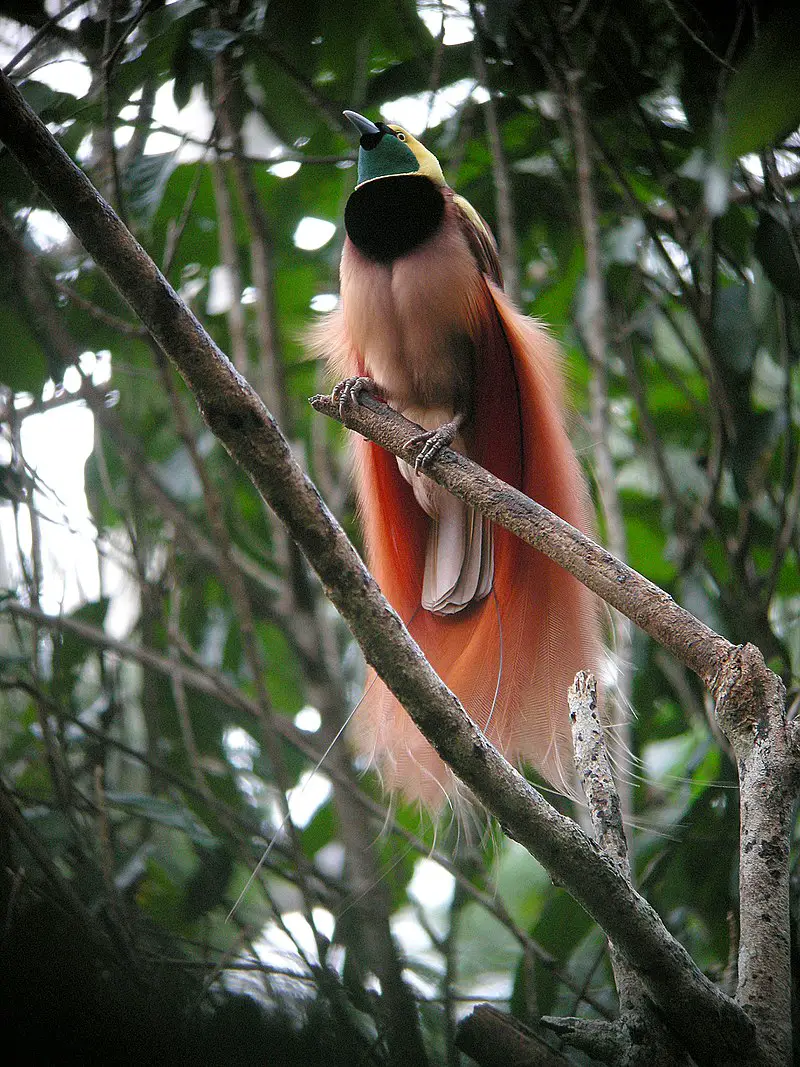
The birds-of-paradise are a family of passerines found mainly in eastern Indonesia, Papua New Guinea and eastern Australia.
These fascinating creatures have 45 species divided into 17 genera and are best known for their vibrant plumage.
Males of the species tend to be more colourful than females, with bright colours such as reds, blues and greens often seen on their feathers.
Their elaborate courtship displays also make them quite unique among other birds; they use various visual cues to attract mates including plumes, tail feathers and even dances.
The diversity of these stunning creatures makes them one of the most captivating bird families in existence today.
Scientific classification:
| Kingdom | Animalia |
| Phylum | Chordata |
| Class | Aves |
| Order | Passeriformes |
| Superfamily | Corvoidea |
| Family | Paradisaeidae Swainson, 1825 |
2. Raggiana Bird-Of-Paradise
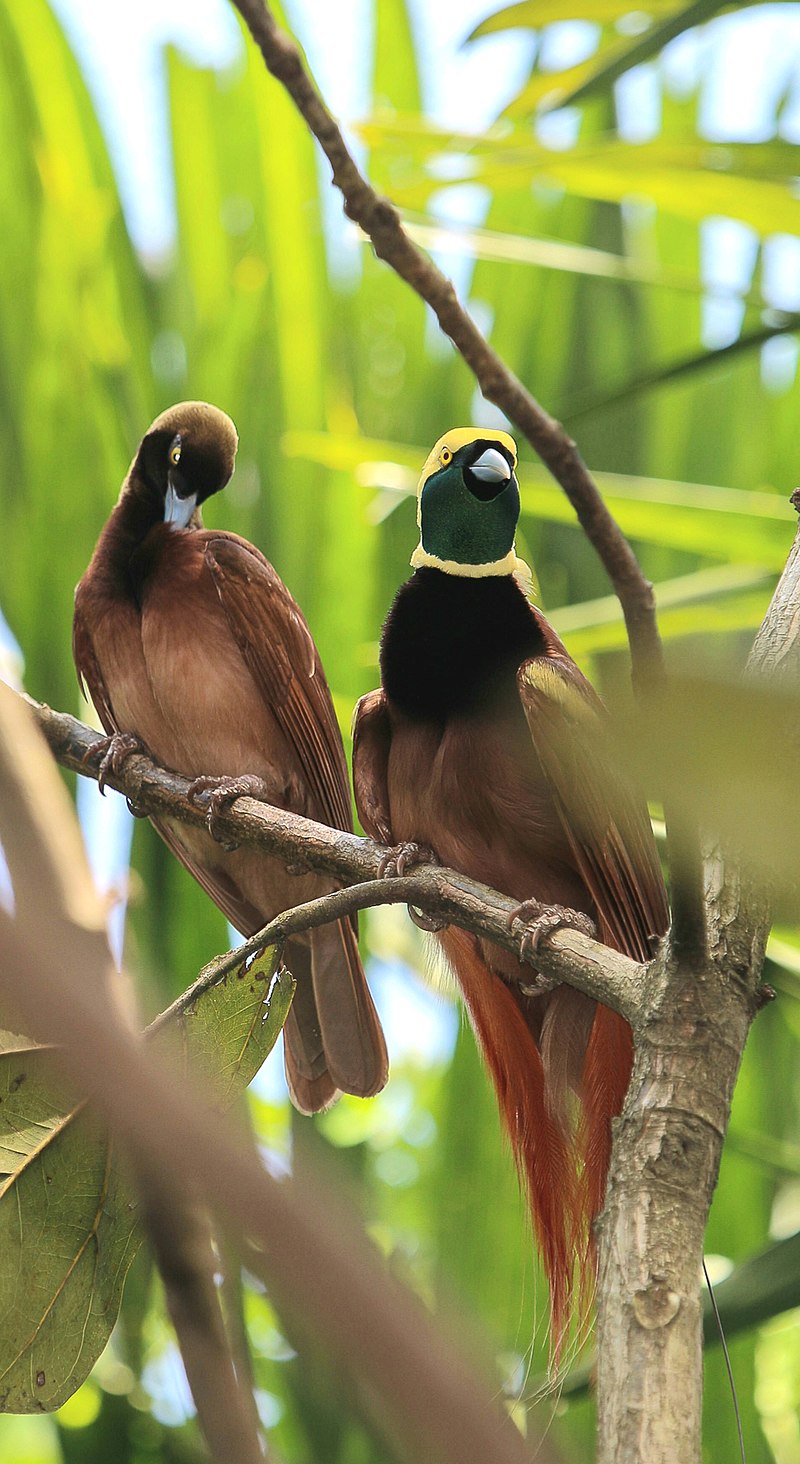
The Raggiana bird-of-paradise is a majestic species of the Paradisaeidae family which can be found in southern and northeastern New Guinea.
It has many names, such as kumul or cenderawasih – its most popular one being Count Raggi’s bird-of-paradise due to it being named after Marquis Francesco Raggi by request of Count Luigi Maria D’Albertis.
This large avian stands out with its striking colors and elegant plumage; males have blue wings and tail feathers, while their chests are chestnut brown with iridescent lacy plumes around them resembling an extravagant coat.
The females show different hues ranging from yellowish green to olive tones on their bodies. Both sexes possess orange feet adorned by impressive curved claws that allow them to keep balance when they dance during mating rituals.
Scientific classification:
| Kingdom | Animalia |
| Phylum | Chordata |
| Class | Aves |
| Order | Passeriformes |
| Family | Paradisaeidae |
| Genus | Paradisaea |
| Species | P. raggiana |
Also Featured In: Beautiful Birds Found in Paradise Island,
3. Southern Cassowary
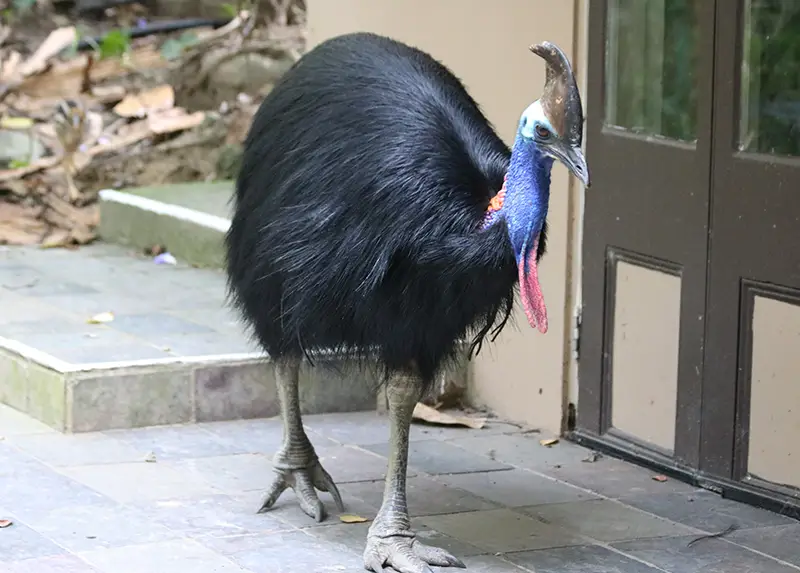
The southern cassowary is a large flightless black bird that can be found in Australia and New Guinea. It belongs to the ratite family, which consists of birds such as emus, ostriches, rheas and kiwis.
The southern cassowary has two wattles (fleshy protrusions) on its neck; this makes it stand out from other species of cassowaries since they usually only have one wattle.
This bird stands at an impressive height of up to 1.5m tall and weighs around 60kg.
They are omnivorous animals but favour fruits over anything else, although they also eat insects, small vertebrates like lizards or snakes and fungi too.
Southern Cassowaries play an important role in maintaining healthy ecosystems by dispersing seeds through their droppings – thus helping forests regenerate naturally.
Scientific classification:
| Kingdom | Animalia |
| Phylum | Chordata |
| Class | Aves |
| Infraclass | Palaeognathae |
| Order | Casuariiformes |
| Family | Casuariidae |
| Genus | Casuarius |
| Species | C. casuarius |
4. Megapode
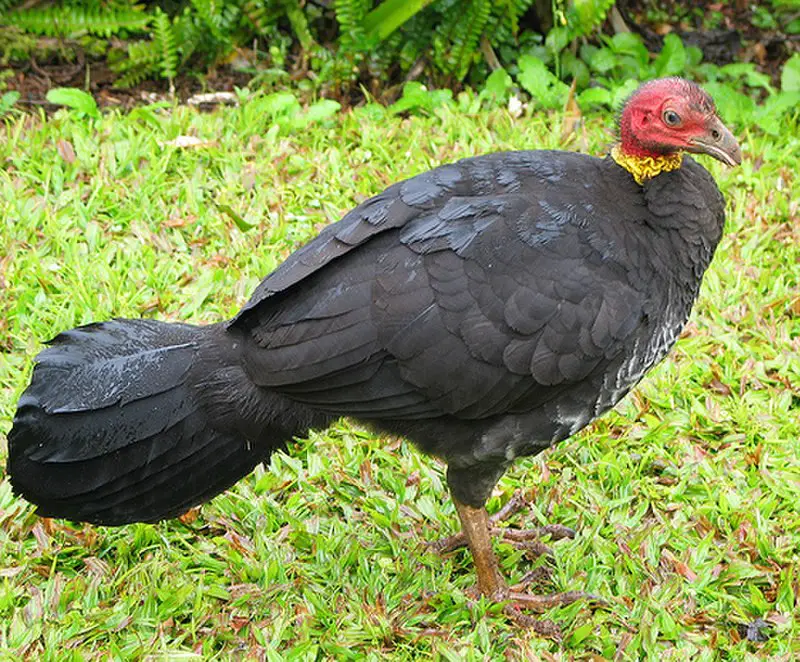
Megapodes are a unique family of birds with large feet and small heads. They measure from medium-large in size, similar to chickens, and have either brown or black feathers covering their bodies.
These terrestrial creatures live mainly in wooded areas where they browse for food like fruits and insects.
With the exception of the Malleefowl species, all Megapodes build mounds which act as incubators for them to lay eggs on – hence why they’re also known as “incubator birds”.
Thanks to this adaptation, these unusual animals can survive extreme temperatures by relying on heat generated from composting material beneath them instead of sitting directly atop their eggs.
Scientific classification:
| Kingdom | Animalia |
| Phylum | Chordata |
| Class | Aves |
| Order | Galliformes |
| Family | Megapodiidae Lesson, 1831 |
Also Featured In: Guam Birds You Need to See, Queensland Birds You Should Know
5. Blyth’s Hornbill
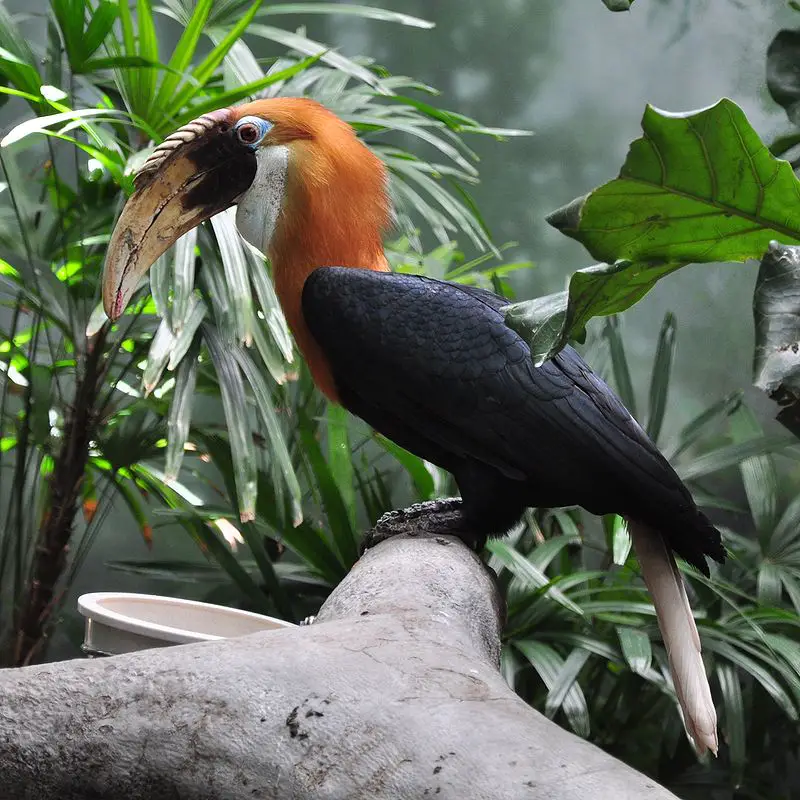
Blyth’s hornbill, or the Papuan Hornbill is a large species of bird that inhabits forests in Wallacea and Melanesia. It is also known as kokomo in Tok Pisin, and was previously placed under the genus Aceros.
This impressive bird has been often confused with its relative -the plain-pouched hornbill (Rhyticeros subruficollis)- but more recently it includes another family member: The Narcondam Hornbill (Rhyticeros narconda).
Blyth’s hornbills are characterized by their long curved beak and wingspan of up to three feet wide; they have dark feathers over most parts of their bodies except for yellowish ones on their tail tip, neck base and chin.
These majestic birds can make quite an impression when flying through a canopy.
Scientific classification:
| Kingdom | Animalia |
| Phylum | Chordata |
| Class | Aves |
| Order | Bucerotiformes |
| Family | Bucerotidae |
| Genus | Rhyticeros |
| Species | R. plicatus |
Also Featured In: Birds that Live Near Halmahera, Bougainville Island Birds You Need to See
6. Ribbon-Tailed Astrapia
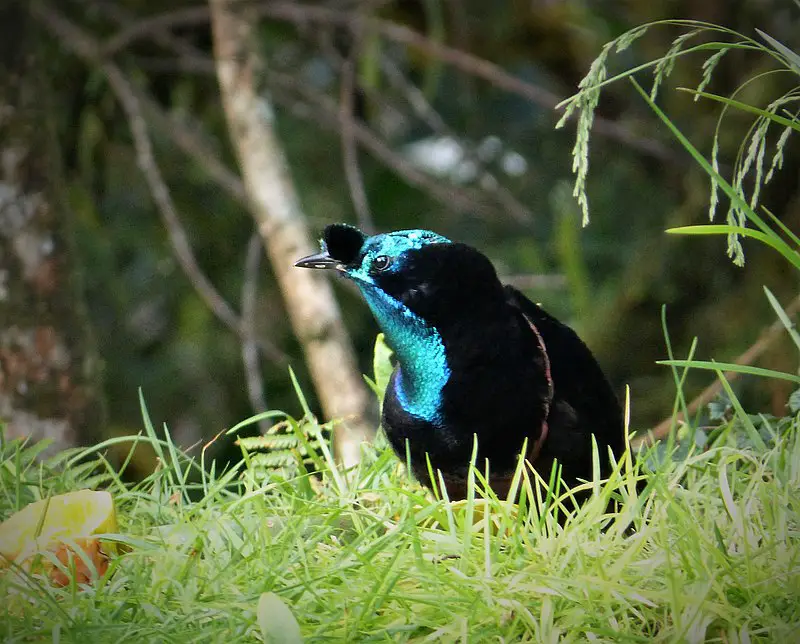
The Ribbon-tailed Astrapia is a species of bird-of-paradise native to the subalpine forests in western Papua New Guinea.
It was discovered relatively recently and has remarkable features, including its lengthy ribboned tail feathers that make up more than two thirds of its total body length.
The male displays an impressive courtship ritual involving exaggerated movements with his brilliantly coloured plumage and elegant dancing for potential mates. Polygamous by nature, males will mate with multiple females throughout their lives.
These birds are truly beautiful creatures that are sure to draw attention from any onlooker lucky enough to witness them in their natural habitat.
Scientific classification:
| Kingdom | Animalia |
| Phylum | Chordata |
| Class | Aves |
| Order | Passeriformes |
| Family | Paradisaeidae |
| Genus | Astrapia |
| Species | A. mayeri |
7. Dwarf Cassowary
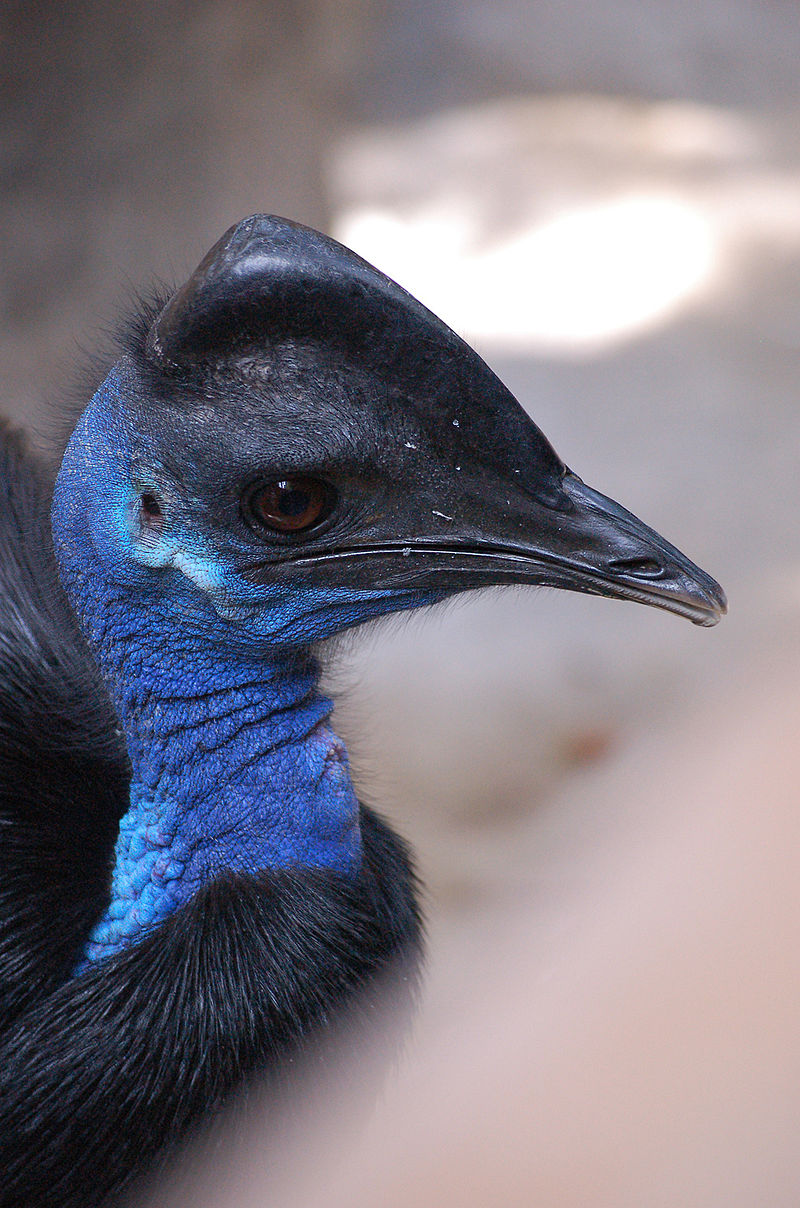
The Dwarf Cassowary is the smallest of its species, standing at around 3-4 feet tall. It can be found in New Guinea and northern Australia. Its plumage ranges from black to a deep purple hue with brighter red chest feathers.
The scientific name of this bird commemorates George Bennett, an Australian naturalist who was among the first to identify it after some were brought aboard a ship from their native environment.
Their diet consists mainly of fruits but they are also known for eating small animals such as lizards or frogs and insects like beetles, grasshoppers and caterpillars; these birds will often use their powerful claws to dig up roots looking for food sources.
They have adapted well to living near humans too which helps them find meals more easily than other cassowaries might in wilder parts of their range.
Scientific classification:
| Kingdom | Animalia |
| Phylum | Chordata |
| Class | Aves |
| Infraclass | Palaeognathae |
| Order | Casuariiformes |
| Family | Casuariidae |
| Genus | Casuarius |
| Species | C. bennetti |
Also Featured In: Common Birds of Indonesia,
8. Blue Bird-Of-Paradise
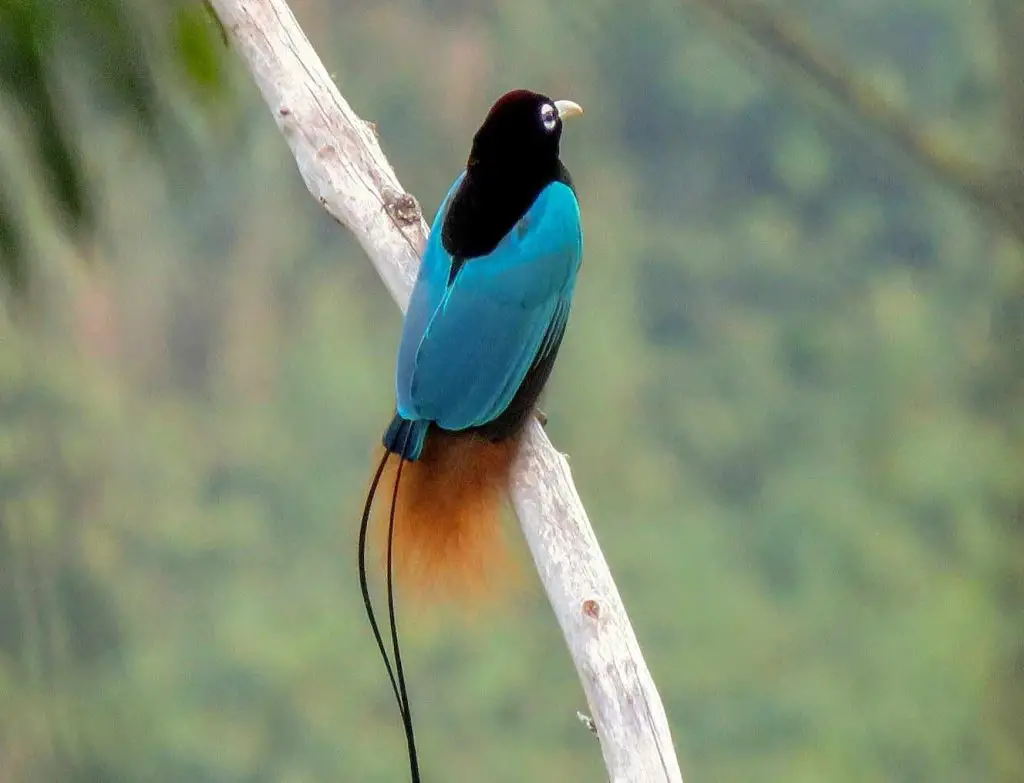
The Blue bird-of-paradise is an exotic and beautiful species of bird found in New Guinea. It’s the only member of its genus Paradisornis, although it was previously included with other birds from the same family in a different genus.
The male has impressive flank feathers that make him stand out amongst all other birds, as well as two long wires trailing behind them.
Their plumage ranges from bright blue to greenish gold depending on their environment and subspecies they belong to.
They are often seen performing courtship dances which involve leaping high into the air before landing gracefully back onto branches or display perches near where potential mates may be present.
Despite being stunningly beautiful these fascinating creatures remain vulnerable due to habitat loss caused by deforestation so we need to ensure that their natural habitats continue to exist for future generations of this remarkable species.
Scientific classification:
| Kingdom | Animalia |
| Phylum | Chordata |
| Class | Aves |
| Order | Passeriformes |
| Family | Paradisaeidae |
| Genus | Paradisornis Finsch & Meyer, A.B., 1886 |
| Species | P. rudolphi |
9. Magpie Goose
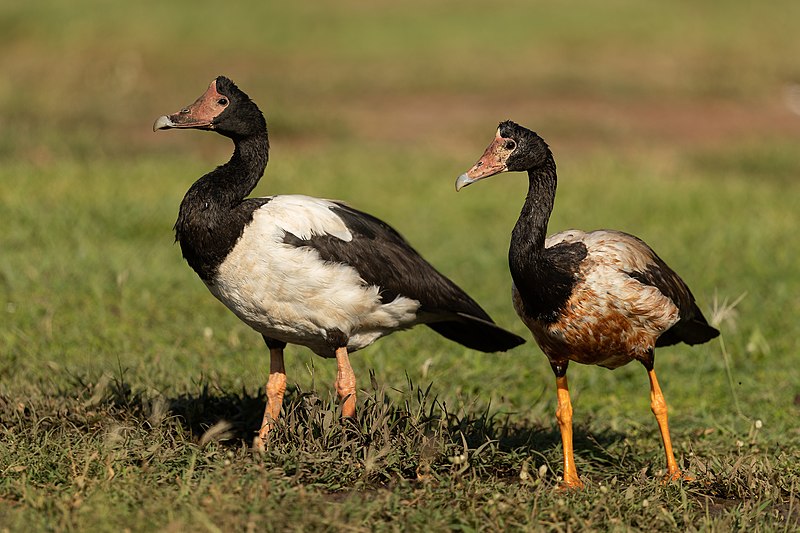
The Magpie Goose is a unique waterbird native to northern Australia and southern New Guinea. It can sometimes be found outside its range due to wandering, but was once widespread in southern Australia until it disappeared.
This species has a distinctive black-and-white plumage with an orange bill and feet which makes them easily recognisable amongst other birds.
They usually live in small flocks around wetlands where they feed on aquatic plants and insects, as well as grain crops when available.
The magpie goose nests near the ground or atop tall vegetation such as reeds or shrubs, laying eggs that are incubated by both parents for up to 30 days before hatching into fluffy yellow goslings.
These beautiful geese have adapted over time so they can survive even during dry periods of their habitats making them an integral part of many wetland ecosystems across Northern Australia and Southern New Guinea.
Scientific classification:
| Kingdom | Animalia |
| Phylum | Chordata |
| Class | Aves |
| Order | Anseriformes |
| Family | Anseranatidae |
| Genus | Anseranas Lesson, 1828 |
| Species | A. semipalmata |
Also Featured In: Birds that Charles Darwin Studied, Birds that Live around Victoria
10. Stone-Curlew

Stone-curlews, also known as dikkops or thick-knees, are a family of birds that have adapted to live in tropical and temperate regions throughout the world.
They can be found in Africa, Asia and Australia with two or more species per region. Despite being classified as waders, most prefer dry arid habitats over moist wetlands.
Stone-curlews typically have long legs which help them navigate through their preferred terrain efficiently; some species even stand at an impressive height when standing on those long legs.
Additionally they feature cryptic plumage which helps them blend into their surroundings while hunting for prey such as insects and small mammals like rodents.
These unique bird’s calls are easily recognizable; it has been said that hearing one is similar to listening to someone whistling ‘Keee Weee’.
Scientific classification:
| Kingdom | Animalia |
| Phylum | Chordata |
| Class | Aves |
| Order | Charadriiformes |
| Suborder | Chionidi |
| Family | Burhinidae Mathews, 1912 |
11. Threskiornithidae
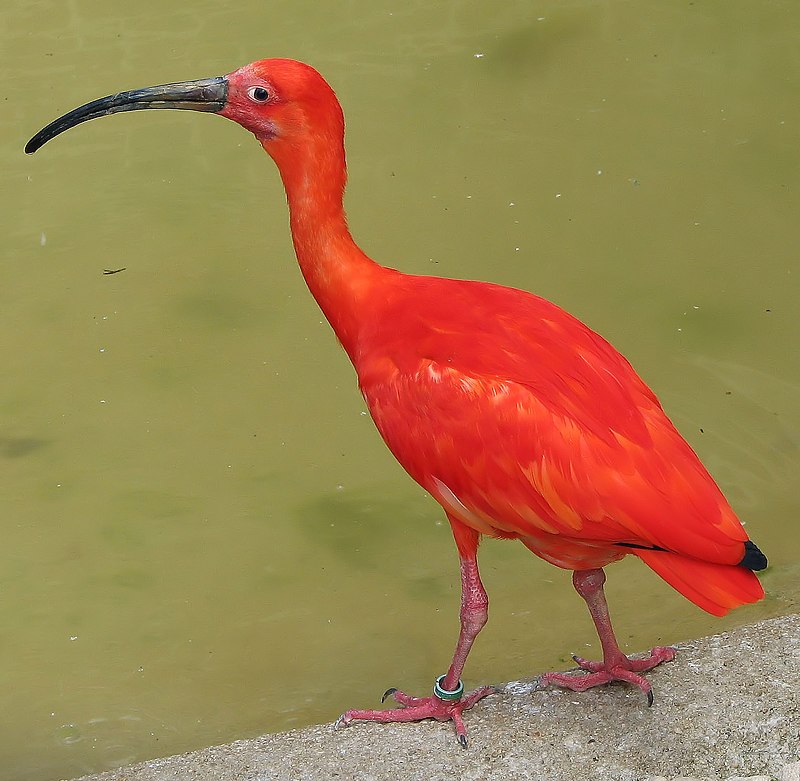
Threskiornithidae is a family of large wading birds which includes 36 species. These birds are traditionally divided into two subfamilies – the ibises and the spoonbills.
However, recent genetic analysis has shown that spoonbills actually belong to Old World ibis group, while New World ibises form an early offshoot from this lineage.
Threskiornithidse members have long curved beaks with serrated edges used for catching fish in shallow water or mudflats, as well as other aquatic invertebrates like crustaceans and mollusks.
They also feed on plant matter such as grains and seeds found close to wetlands areas where they live.
This diverse diet makes them important scavengers in their ecosystems, helping maintain healthy populations of native wildlife by controlling insect numbers and dispersing energy-rich seeds throughout wetland habitats.
Scientific classification:
| Kingdom | Animalia |
| Phylum | Chordata |
| Class | Aves |
| Order | Pelecaniformes |
| Suborder | Ardei |
| Family | Threskiornithidae Richmond, 1917 |
12. Plovers

Plovers are a family of around 64-68 species of ground-dwelling birds, commonly found in open country such as fields, meadows and tundras.
They have short bills with webbed feet to help them forage through mud or shallow water.
Plover plumage is usually mottled brown though some species may have brighter colors on the head and wings.
These birds feed mainly on insects but can also eat small crustaceans and worms.
Plovers breed during springtime when they dig holes in sandy or pebbled beaches to lay their eggs which hatch after about 3 weeks incubation period.
They use distraction display behaviour by pretending an injury to the predators away from their nests if needed for protecting their young ones.
Scientific classification:
| Kingdom | Animalia |
| Phylum | Chordata |
| Class | Aves |
| Order | Charadriiformes |
| Family | Charadriidae Leach, 1820 |
13. Stilts And Avocets
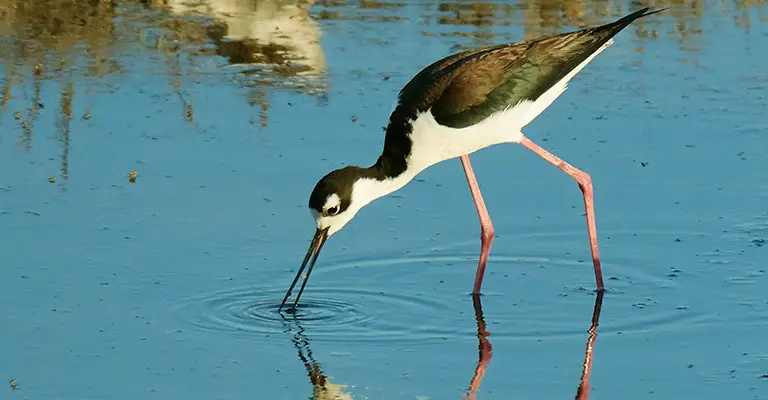
Stilts and avocets are two distinct groups of birds belonging to the family Recurvirostridae. They range in length from 30-46 cm (12-18 inches) and weigh between 140 – 435 g (4.9 – 15.3 ounces).
Males usually have slightly larger bodies than females, with long thin legs, necks and bills.
Avocet bills curve upwards uniquely while stilt beaks remain straight most times.
These wading birds live mainly near shorelines or wetlands where they feed on aquatic invertebrates like brine shrimp, insects etc., occasionally supplementing their diet with seeds or small fish too.
Stilts also inhabit open fields in search of food sources such as earthworms or grasshoppers during the non-breeding season.
Both groups migrate over large distances for warmer weathers when it gets cold outside.
Scientific classification:
| Kingdom | Animalia |
| Phylum | Chordata |
| Class | Aves |
| Order | Charadriiformes |
| Suborder | Charadrii |
| Family | Recurvirostridae Bonaparte, 1854 |
14. Glareolidae
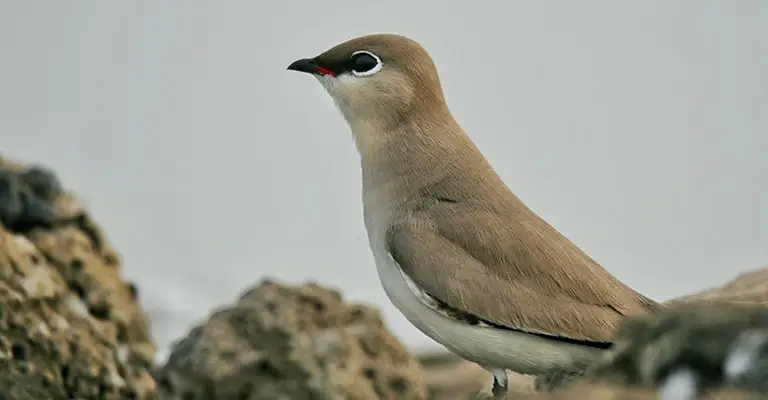
Glareolidae is a family of wading birds, consisting of four genera and 17 species. They are distinguished from other charadrii by their long bills which have a slight downward curve.
Glareolidae live around open grasslands and deserts, where they hunt for insects using the bill to probe into soil or vegetation.
Most species are found in Africa but two pratincoles inhabit parts of Europe and Asia as well.
Coursers tend to be larger than pratincoles with longer legs allowing them to run quickly across sandy dunes while feeding on small animals like lizards or spiders.
Pratincoles feed mainly on flying insects, snatching them out of midair with great agility during flight.
All glareolids share unique features such as large eyes that help it spot prey at night easily making this group one interesting bird family.
Scientific classification:
| Kingdom | Animalia |
| Phylum | Chordata |
| Class | Aves |
| Order | Charadriiformes |
| Suborder | Lari |
| Family | Glareolidae CL Brehm, 1831 |
15. Austral Storm Petrels
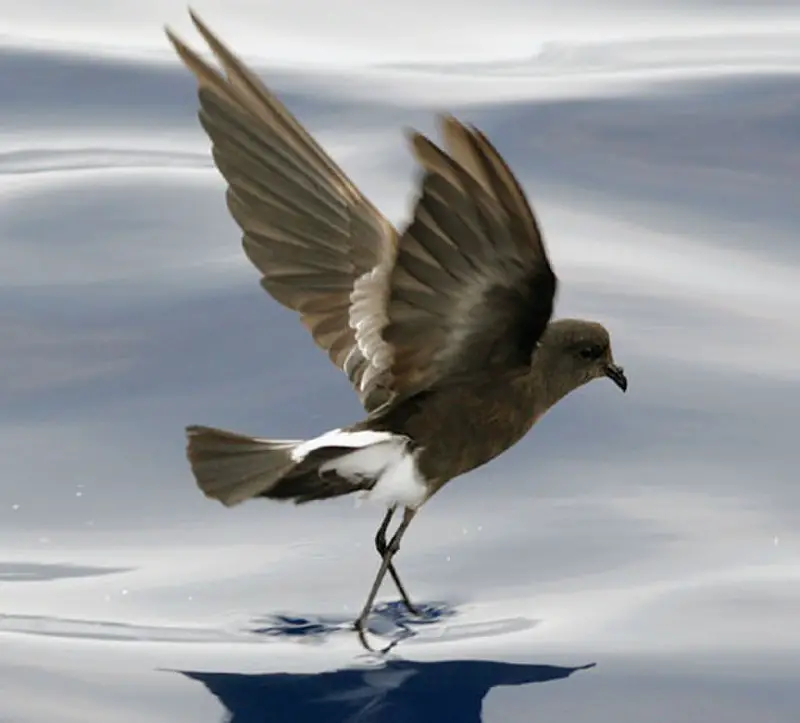
Austral Storm Petrels are the smallest of seabirds, belonging to the family Oceanitidae and order Procellariiformes.
They have a cosmopolitan distribution across all oceans, with their flight being fluttering and sometimes bat-like in appearance.
These birds feed on planktonic crustaceans as well as small fish that they pick from the surface while hovering over it.
Their plumage is mostly dark grey or blackish brown above; underparts may be white or mottled gray.
The feet vary between species but usually have pale yellow webs and claws which help them move easily through water when searching for food.
Austral storm petrels often make nests on remote islands where these birds can breed safely without any disturbances from humans during their nesting season.
Scientific classification:
| Kingdom | Animalia |
| Phylum | Chordata |
| Class | Aves |
| Order | Procellariiformes |
| Family | Oceanitidae Forbes, 1881 |
16. Aegothelidae
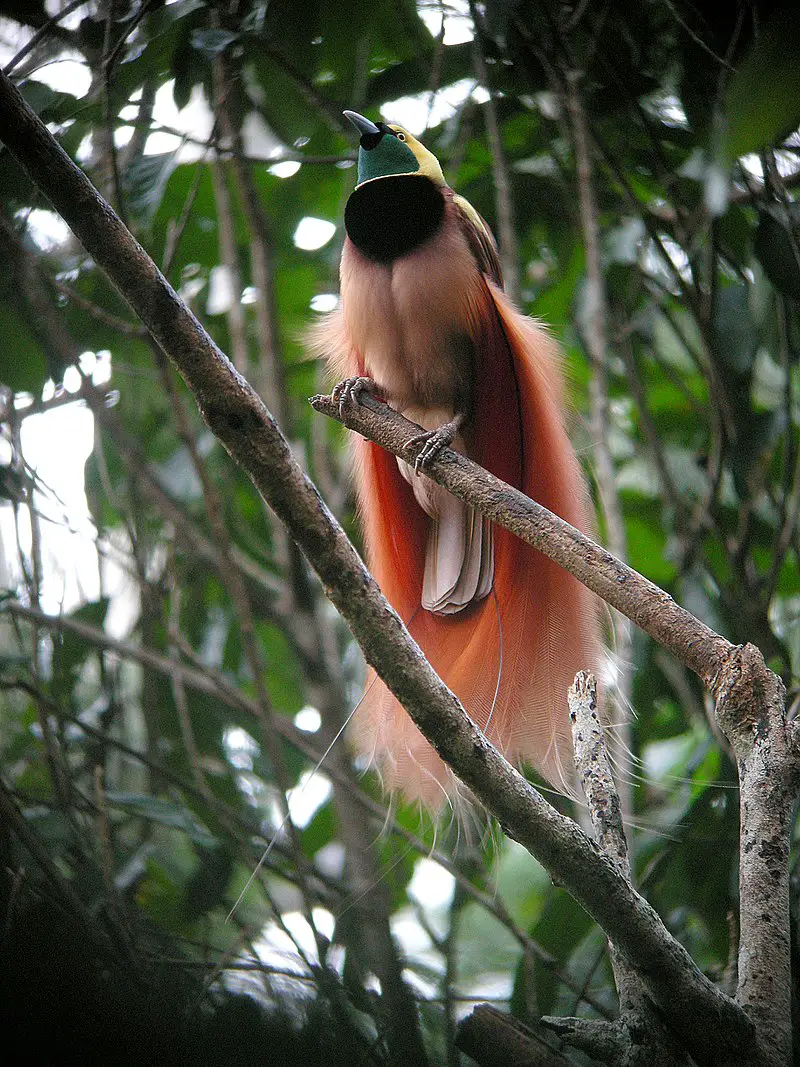
Aegothelidae is a family of small- to medium-sized owls found across Australasia, Indonesia and New Guinea. They are also known as the “barking” or “boobook” owls due to their distinctive vocalizations that resemble dogs barking.
These birds range in size from 18–23 cm long with rounded wings and relatively short tails when compared to other owl species.
Their plumage ranges from grayish browns or tawny colors with darker barring on the chest and belly feathers, giving them excellent camouflage against tree bark where they often perch during daylight hours.
Aegothelids feed primarily on insects but may take larger prey such as lizards or mice depending upon availability in their habitat.
Due to its large distribution area, these birds face threats from deforestation which reduces available nesting sites for this species; however some populations remain stable despite localized declines elsewhere throughout their range
17. Fire-Maned Bowerbird
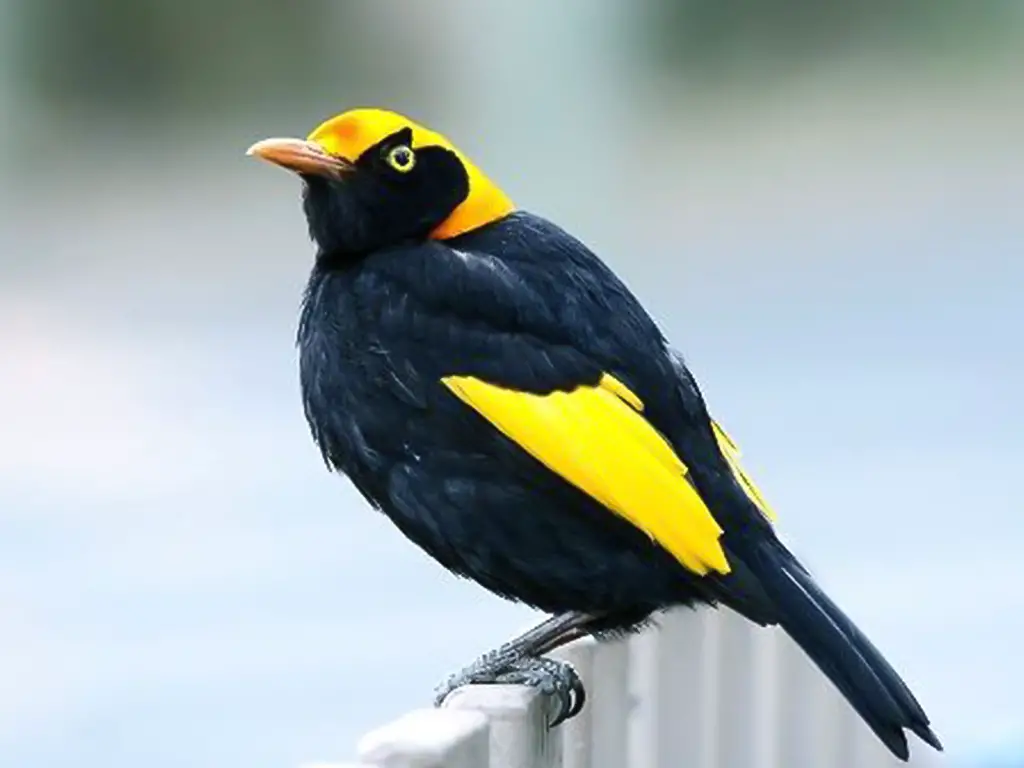
The Fire-maned Bowerbird is a stunning bird species endemic to the forests of Papua New Guinea’s Adelbert Range. Males have an entirely black body, with fiery orange crown and upperback, elongated neck plumes, yellow iris and golden yellow wing patch.
Females are brown in colour with white underparts covered in brown bars. This medium-sized bowerbird measures approximately 27 cm (11 in) long; its diet consists mainly of fruits and insects found within its natural habitat.
The spectacular plumage on display during courtship rituals helps attract potential mates for breeding purposes – they build elaborate structures known as ‘bowers’ which males decorate using unique items such as flowers or shells gathered from their surroundings.
The Fire-maned Bowerbird is a fascinating species that demands conservation action if it is to survive into future generations.
Scientific classification:
| Kingdom | Animalia |
| Phylum | Chordata |
| Class | Aves |
| Order | Passeriformes |
| Family | Ptilonorhynchidae |
| Genus | Sericulus |
| Species | S. bakeri |
18. Satinbird
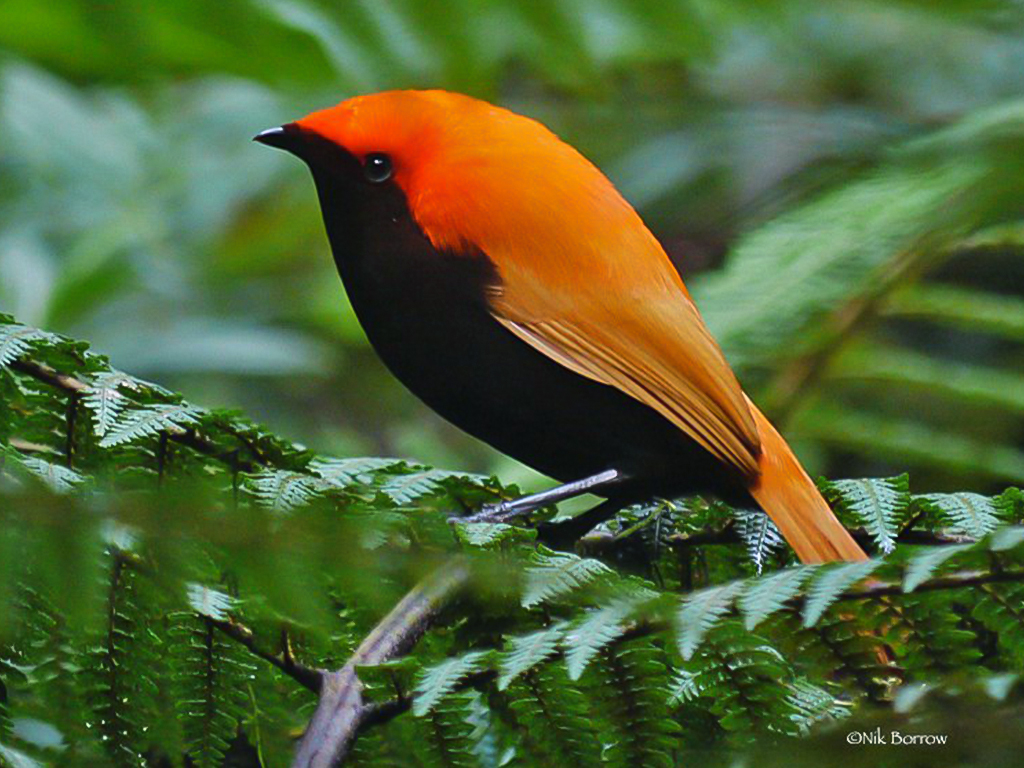
Satinbirds are a family of passerine birds native to the mountain forests of New Guinea. These small, colorful birds have distinctive long tails and bright plumage consisting of black, red and yellow colors.
They feed on fruits, berries and insects which they catch in their beaks while foraging among foliage or perching atop branches.
Satinbirds live in pairs or small groups but will sometimes come together for larger flocks during migration periods when food is scarce.
Despite being closely related to berry peckers and longbills, these plucky little birdies show distinct behavior from other species including vocalizing with higher pitched notes than other members within its family tree as well as utilizing trees more often for nesting purposes rather than simply roosting upon them at night like others do.
Scientific classification:
| Kingdom | Animalia |
| Phylum | Chordata |
| Class | Aves |
| Order | Passeriformes |
| Suborder | Passeri |
| Family | Cnemophilidae Mayr, 1862 |
19. Flame Bowerbird
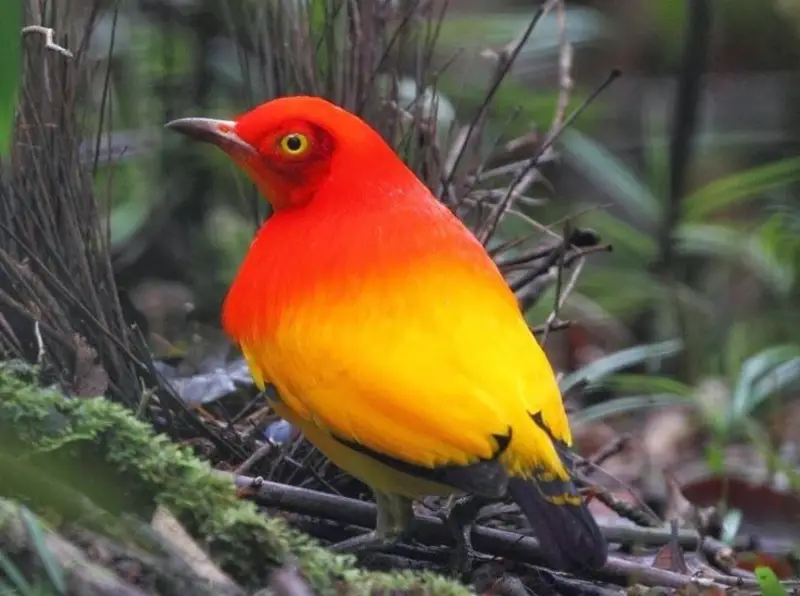
The Flame Bowerbird is a stunningly beautiful species of bowerbird native to Australia. The male has flame orange and golden yellow plumage, elongated neck plumes and a black tail tipped with bright yellow.
It builds an avenue-type bower consisting of two walls made from sticks as well as decorations such as pebbles, shells or feathers. On the other hand, females are olive brown in color with some yellow or gold around the stomach area.
This species can reach up to 25 cm in length when fully grown making it one of the medium-sized birds among its kind. Its dazzling colors make it stand out amongst all other bird species found in Australia.
Scientific classification:
| Kingdom | Animalia |
| Phylum | Chordata |
| Class | Aves |
| Order | Passeriformes |
| Family | Ptilonorhynchidae |
| Genus | Sericulus |
| Species | S. ardens |
20. Rufous-Backed Honeyeater
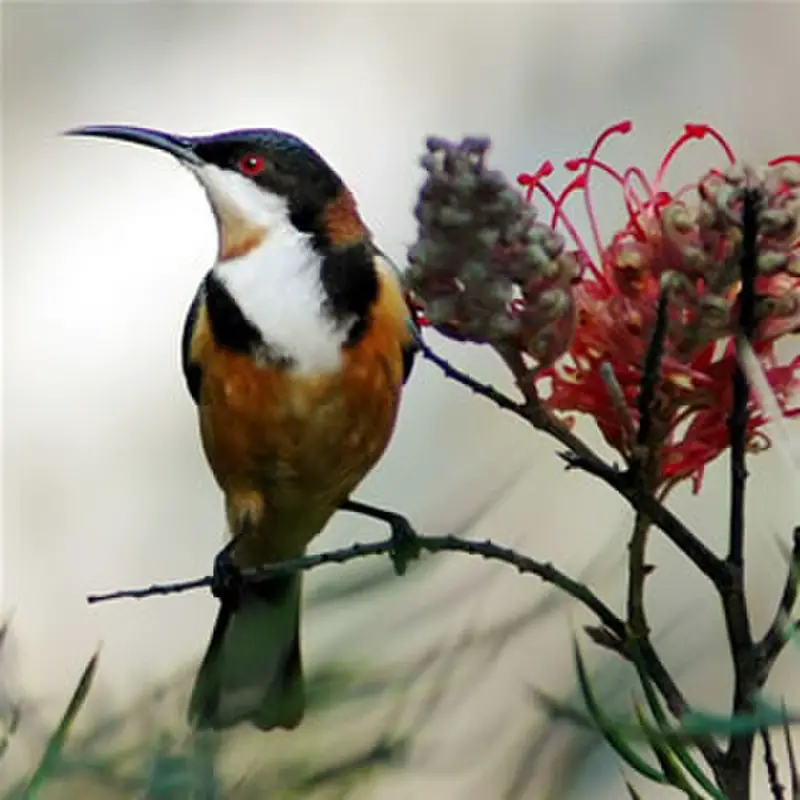
The Rufous-backed Honeyeater is an amazing bird, found only in the montane forests of Papua New Guinea. It has a distinctive rufous back and yellowish underparts, making it unmistakable among other birds native to the area.
This species feeds on nectar from flowering plants as well as insects, spiders and small lizards which they catch with their long curved bills.
Their habitat is threatened due to deforestation caused by logging activities, along with increasing agricultural land being converted for use by humans.
As such this species faces significant threats to its survival and conservation efforts are essential if we’re going to protect these beautiful birds into the future.
Scientific classification:
| Kingdom | Animalia |
| Phylum | Chordata |
| Class | Aves |
| Order | Passeriformes |
| Family | Meliphagidae |
| Genus | Ptiloprora |
| Species | P. guisei |
21. Melanesian Megapode
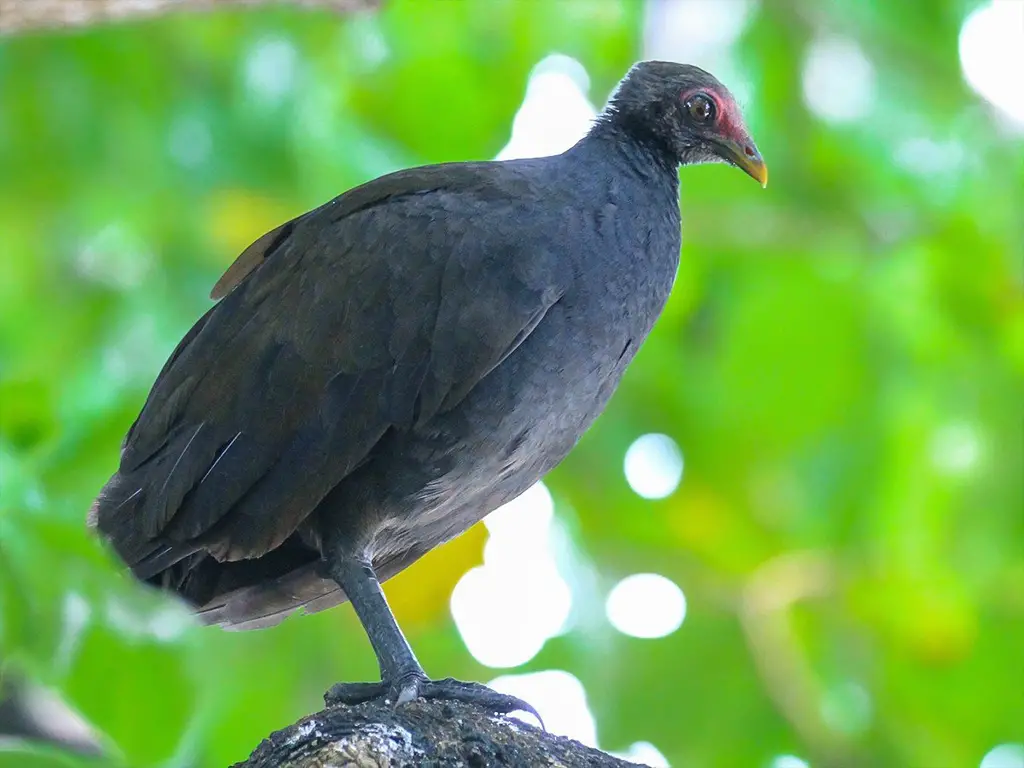
The Melanesian scrubfowl, also known as the Melanesian megapode, is a unique bird species endemic to islands in the Melanesia region.
It has an unusual incubation strategy that involves relying on environmental heat sources rather than sitting on its eggs like most birds do.
This species holds cultural importance for Indigenous peoples of this area and they have two names commonly used to refer it: Megapodi or Scrubfowl.
The megapod has brown feathers with yellowish-buff markings across its body and wings; red legs; long toes for digging; and a black crest at the top of its head.
Its diet consists mostly of fruit seeds, insects, snails and other invertebrates found in leaf litter during their daily search for food through dense vegetation near streams or pools.
All these adaptations make them well suited to live in forests located between oceanic shores up into highland areas surrounded by tropical rainforest habitat .
Scientific classification:
| Kingdom | Animalia |
| Phylum | Chordata |
| Class | Aves |
| Order | Galliformes |
| Family | Megapodiidae |
| Genus | Megapodius |
| Species | M. eremita |
22. Common Smoky Honeyeater
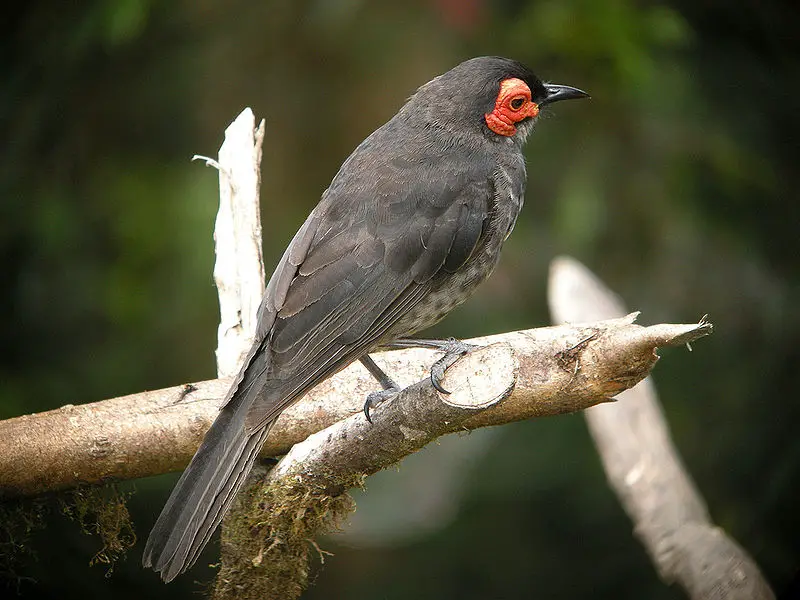
The Common smoky honeyeater is a species of bird in the Meliphagidae family, found only in New Guinea. It’s one of four species belonging to its genus, and closely related with the Wattled Smoky Honeyeater which was discovered in 2005.
This small passerine has mainly gray plumage on its wings and back, while it’s throat feathers are white or yellowish-white.
Its eyes have an orange hue that stands out against their grey head coloration. The diet of this honey eater consists mainly of nectar from flowers as well as insects for protein intake.
Like other birds within the same family they will use their long curved bills to feed on both native and introduced flowering plants due to deforestation outside protected areas such as national parks As they fly between trees searching for food they make loud chattering noises alerting each other when prey is spotted making them quite vocal creatures.
Scientific classification:
| Kingdom | Animalia |
| Phylum | Chordata |
| Class | Aves |
| Order | Passeriformes |
| Family | Meliphagidae |
| Genus | Melipotes |
| Species | M. fumigatus |
23. Forest Kingfisher
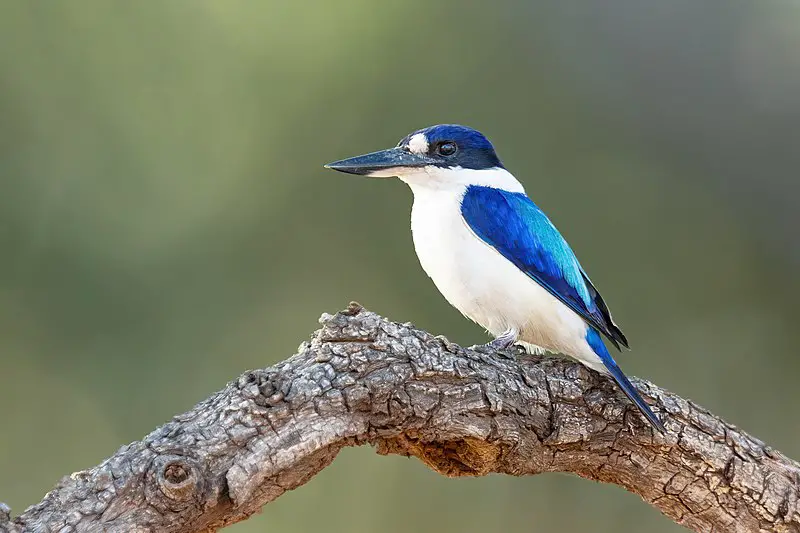
The Forest Kingfisher is an exquisite bird, boasting a vibrant blue and white plumage. It can be found in Indonesia, New Guinea, parts of Australia and other coastal areas.
This kingfisher prefers to hunt for invertebrates as well as small frogs or lizards, making it one of the most diverse hunters among its species.
Its diet helps to keep insect populations under control while also providing sustenance for this beautiful creature.
With its striking colors and impressive hunting skills, the Forest Kingfisher stands out amongst other birds living in similar habitats.
Scientific classification:
| Kingdom | Animalia |
| Phylum | Chordata |
| Class | Aves |
| Order | Coraciiformes |
| Family | Alcedinidae |
| Subfamily | Halcyoninae |
| Genus | Todiramphus |
| Species | T. macleayii |
Also Featured In: Native Birds Of Mackay,
24. MacGregor’s Bowerbird
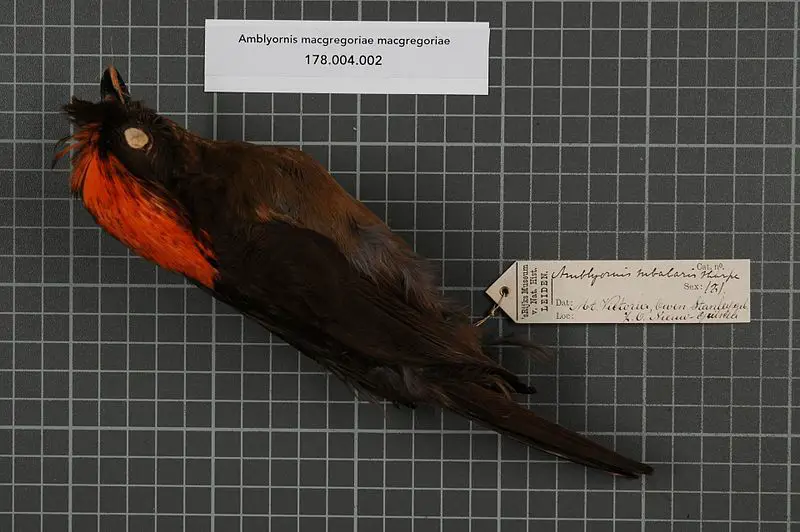
MacGregor’s bowerbird is a medium-sized, olive brown bird native to the mountain forests of New Guinea. It stands about 26 cm in length and has an orange yellow crest that can be raised during courtship display.
The female lacks this distinctive feature but otherwise looks similar to males.
This species makes its living by collecting fruits and insects from trees, while their most remarkable behavior involves constructing elaborate structures known as bowers for mating purposes – hence their name.
They build these using sticks and twigs carefully arranged into two walls which they decorate with colorful objects such as snail shells or flowers found nearby.
MacGregor’s bowerbirds are highly social creatures who enjoy gathering together around sources of food in order to feed collectively.
Scientific classification:
| Kingdom | Animalia |
| Phylum | Chordata |
| Class | Aves |
| Order | Passeriformes |
| Family | Ptilonorhynchidae |
| Genus | Amblyornis |
| Species | A. macgregoriae |
25. Barking Owl
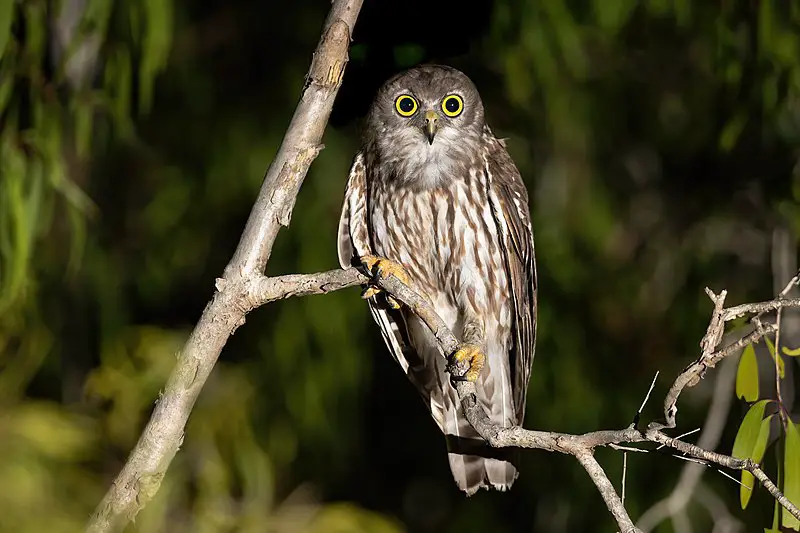
The Barking Owl is a medium-sized brown owl native to Australia, New Guinea and the Moluccas. It has a distinct barking or howling call which gives it its name.
They are nocturnal birds who hunt small prey such as insects, mammals and reptiles at night. The males have larger heads and longer wings than females making them more easily identifiable in flight.
During the day they roost in dense foliage providing excellent camouflage against potential predators.
Their diet consists of rodents, rabbits and some smaller birds like finches or doves but they also eat invertebrates like spiders, worms and frogs too.
With their large eyes adapted for night vision these owls can spot even tiny movement from far away allowing them to catch unsuspecting prey with ease.
Scientific classification:
| Kingdom | Animalia |
| Phylum | Chordata |
| Class | Aves |
| Order | Strigiformes |
| Family | Strigidae |
| Genus | Ninox |
| Species | N. connivens |
26. Black Honey Buzzard
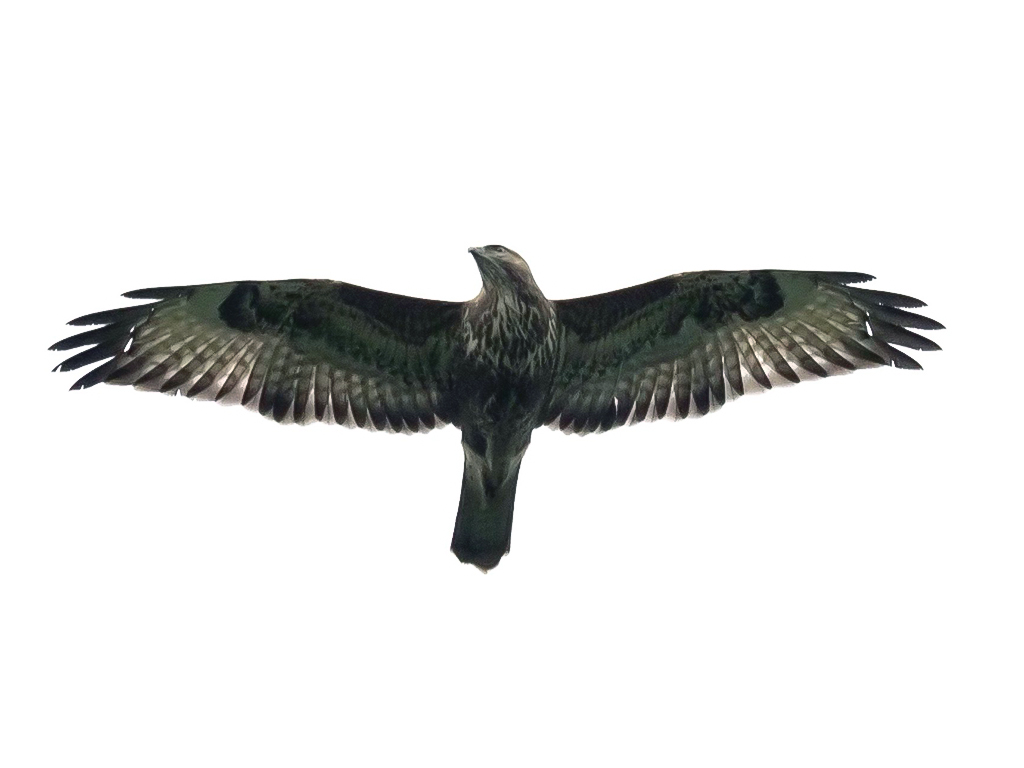
The Black Honey-Buzzard is a large raptor of the Accipitridae family, standing at around 50 cm tall. It has an impressive black body with striking white bands on its tail and flight feathers which makes it quite easy to spot when flying.
Its wings are noticeably long compared to other birds of prey, making it stand out in the sky.
The diet consists mainly of insects such as bees, wasps and ants that they catch by swooping down from high above or hovering over them while searching for food below.
They also occasionally consume small reptiles, amphibians and rodents too.
This bird can be found across parts of New Britain Island where there is plenty enough space for these beautiful creatures to soar freely through their natural habitat.
Scientific classification:
| Kingdom | Animalia |
| Phylum | Chordata |
| Class | Aves |
| Order | Accipitriformes |
| Family | Accipitridae |
| Genus | Henicopernis |
| Species | H. infuscatus |
Also Featured In: Birds that are Found in New Britain,
27. Spangled Honeyeater
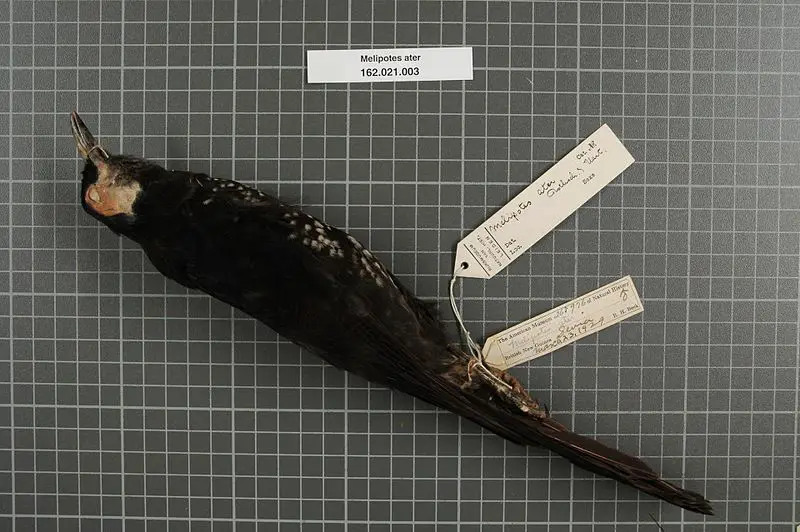
The Spangled Honeyeater is a species of bird from the Meliphagidae family, that can only be found in Papua New Guinea’s Huon Peninsula.
It lives in subtropical or tropical moist montane forests and has an impressive black color with white spots on its wings and tail feathers.
This unique little creature feeds mainly on nectar but also eats insects, fruit, seeds, flowers and other small animals like frogs when they are available.
Its diet makes it quite important to maintain balance within its natural environment since it contributes to pollination of plants as well as regulating insect populations through predation.
Unfortunately this beautiful bird faces threats such as deforestation due to logging activities which have led to loss of habitat for many animal species including the spangled honeyeater.
Scientific classification:
| Kingdom | Animalia |
| Phylum | Chordata |
| Class | Aves |
| Order | Passeriformes |
| Family | Meliphagidae |
| Genus | Melipotes |
| Species | M. ater |
28. White-Bellied Whistler
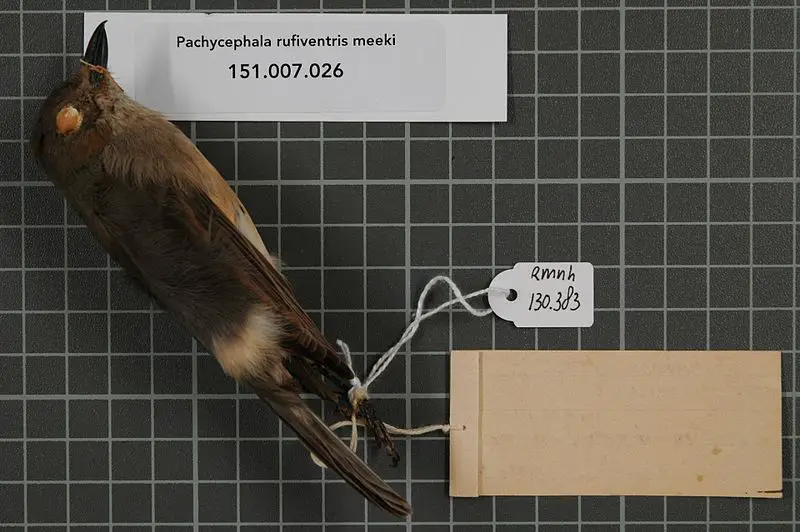
The White-bellied Whistler is a rare species of bird found in two small patches of northern New Guinea, one patch in southeastern New Guinea and on Rossel Island.
It can be seen inhabiting wet lowland forests near the coast as well as mangroves and open woodlands.
Its plumage has a mottled grey head, white underbelly with brown upperparts which helps it blend into its environment for camouflage.
The male also sports a black eye mask that furthers this effect. While not much else is known about their behavior or diet, they are typically quite vocal birds making melodious whistles to communicate within groups or attract mates during mating season.
Scientific classification:
| Kingdom | Animalia |
| Phylum | Chordata |
| Class | Aves |
| Order | Passeriformes |
| Family | Pachycephalidae |
| Genus | Pachycephala |
| Species | P. leucogastra |
29. Blue-Eyed Cockatoo
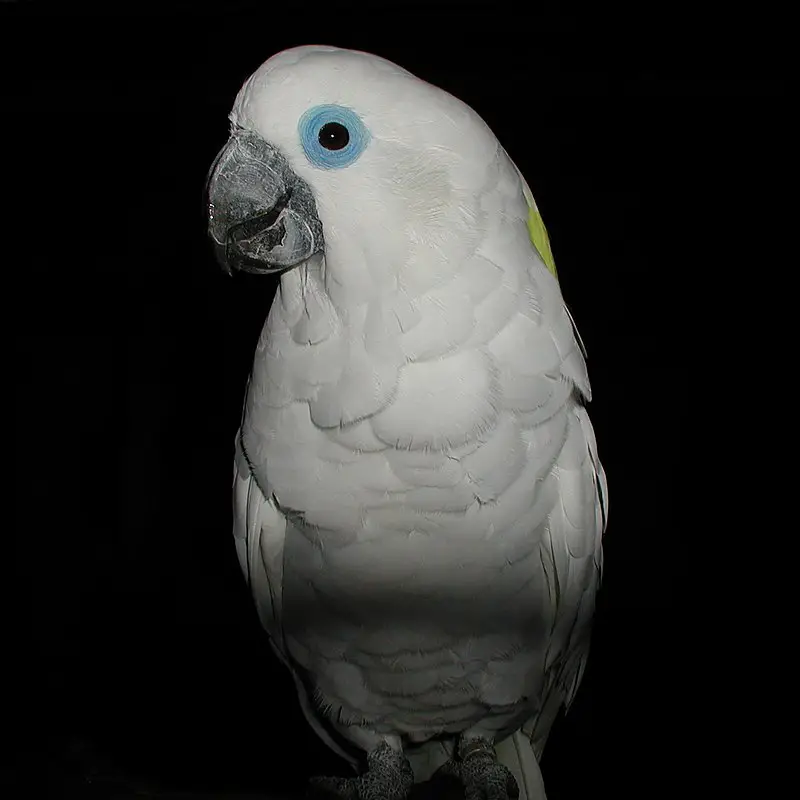
The Blue-eyed Cockatoo is a majestic bird native to Australia and New Guinea. It has an impressive wingspan of 50 centimeters, and its striking plumage consists of white feathers with a mobile crest on top.
Its most distinctive feature is the light blue ring of featherless skin around each eye that gives this species its name.
The beak is black in color, adding further character to this magnificent creature. This parrot can use one foot at a time to hold objects or bring food up near its beak whilst standing on the other foot – something many cockatoos are capable of doing as well.
They tend to live in small groups within their natural habitat, where they feed off fruits, nuts and seeds found amongst the trees. A truly remarkable bird indeed.
Scientific classification:
| Kingdom | Animalia |
| Phylum | Chordata |
| Class | Aves |
| Order | Psittaciformes |
| Family | Cacatuidae |
| Genus | Cacatua |
| Subgenus | Cacatua |
| Species | C. ophthalmica |
30. Northern Cassowary
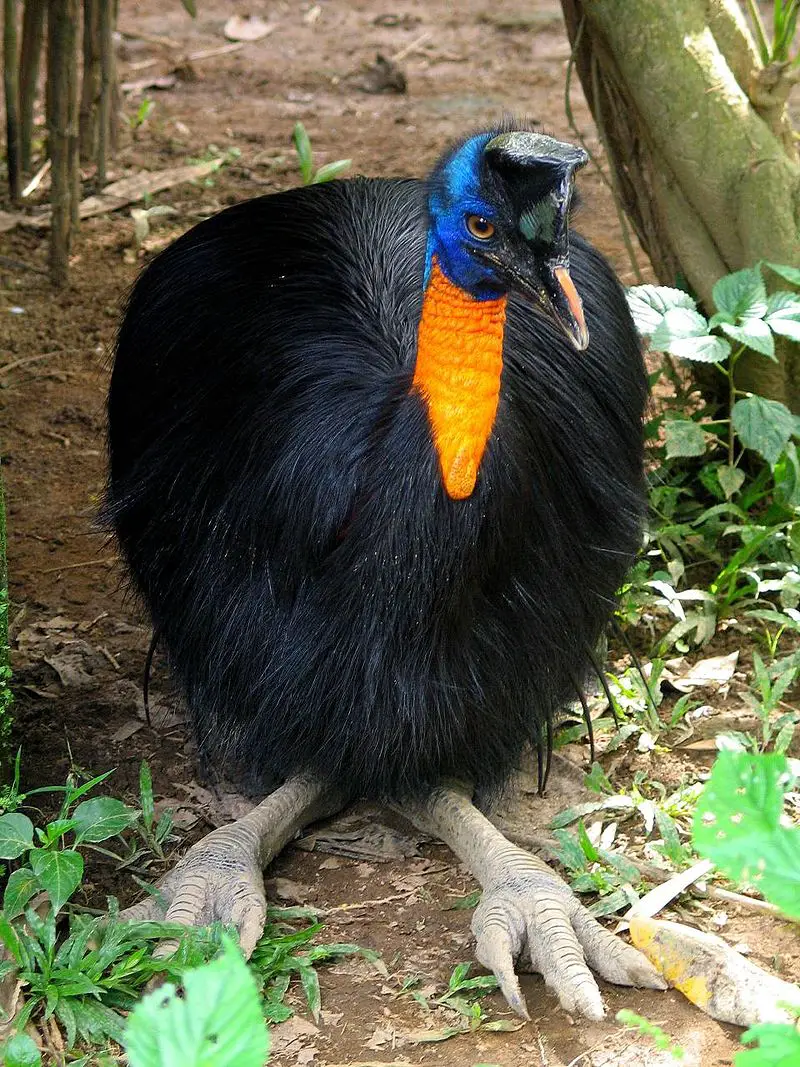
The Northern Cassowary is a large, flightless bird that inhabits the forests of northern New Guinea. It was first discovered by Edward Blyth in 1878 and belongs to the superorder Paleognathae.
This species has an unmistakable appearance with its black plumage, vibrant blue neck wattles and bright yellow casque atop its head.
The cassowary can reach up to 1.5 metres tall and weigh between 20-50 kgs depending on their age and gender; it is also one of the most dangerous birds due to powerful legs equipped with long claws used for defence against predators or challengers.
They feed mostly on fruits but will consume small animals such as lizards if presented another food source becomes scarce – making them omnivores overall.
Despite its somewhat intimidating size, this remarkable bird plays an essential role within its ecosystem providing vital services like seed dispersal which allows plants to spread throughout new regions & aiding in nutrient cycling through decomposing animal matter from decaying fruit they eat helping maintain healthy soil quality.
Scientific classification:
| Kingdom | Animalia |
| Phylum | Chordata |
| Class | Aves |
| Infraclass | Palaeognathae |
| Order | Casuariiformes |
| Family | Casuariidae |
| Genus | Casuarius |
| Species | C. unappendiculatus |
Also Featured In: Common Tropical Rainforest Birds, Birds Typically Found in Australian Rainforest
31. Purple-Bellied Lory
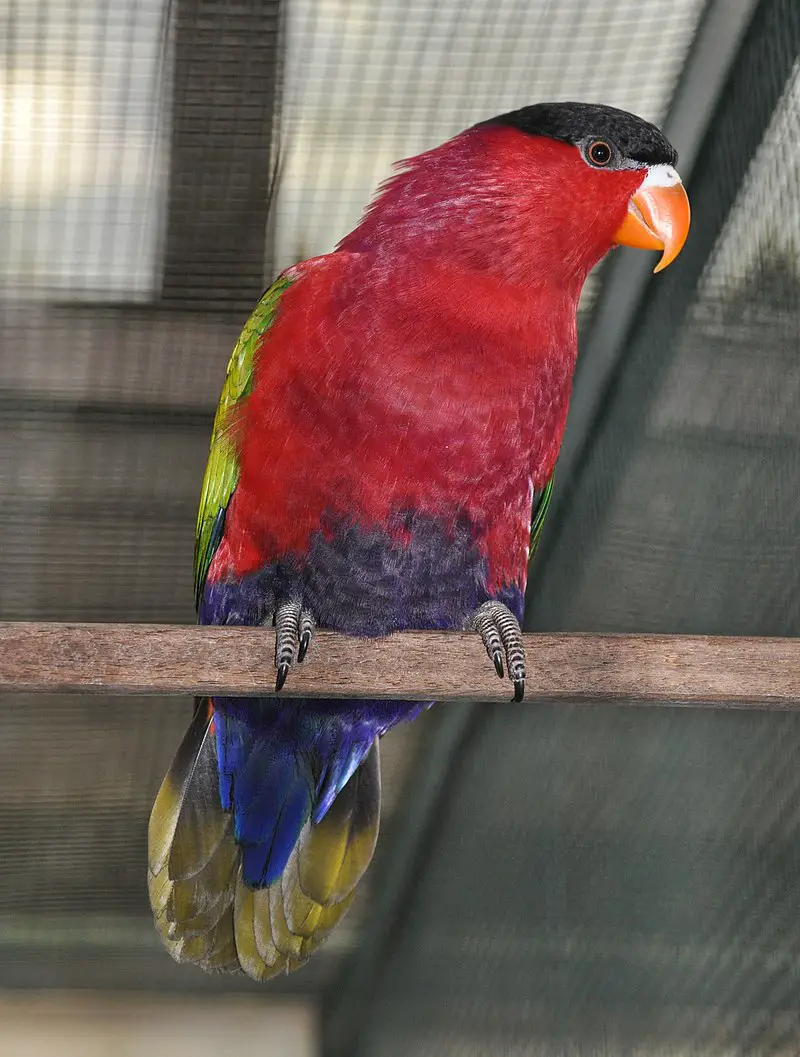
The beautiful Purple-bellied Lory is a species of parrot endemic to Papua New Guinea. It has a distinctive purple belly, and can be found in the south-east region as well as various archipelagos such as Bismarck, Louisiade, Trobriand and Woodlark Island.
The bird’s natural habitats are subtropical or tropical lowland forests and mangrove areas that provide plenty of food sources for them.
They feed mainly on nectar from flowers which gives them their vibrant colors – blue wings with yellow heads along with red underparts makes these birds quite easy to spot among other species.
In addition they also eat fruits, insects and small vertebrates like lizards making them omnivores in nature.
Scientific classification:
| Kingdom | Animalia |
| Phylum | Chordata |
| Class | Aves |
| Order | Psittaciformes |
| Family | Psittaculidae |
| Genus | Lorius |
| Species | L. hypoinochrous |
32. White-Chinned Myzomela
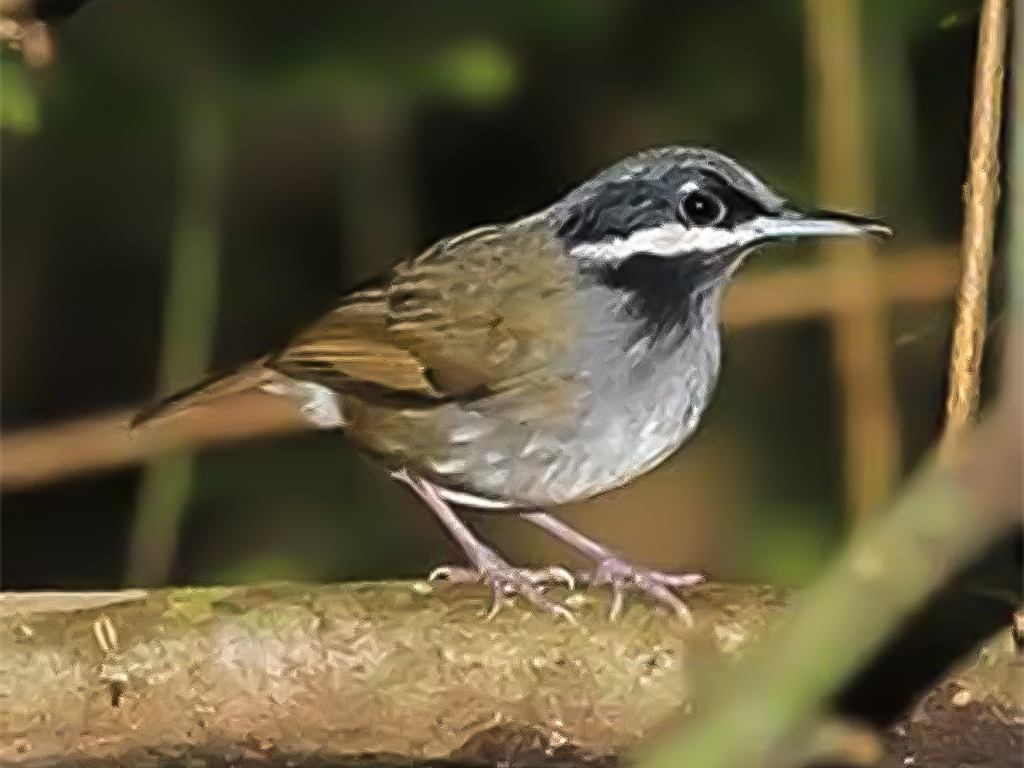
The White-chinned myzomela is a species of bird found in the Louisiade Archipelago. It belongs to the Meliphagidae family, and it has a distinctive white chin which gives its name.
It is known for its bright red plumage on its head, back and wings with some yellow accents. Its underparts are mostly greyish white.
The adult male also shows an orange patch near his forehead while females tend to be more subdued in coloration overall.
This delightful little songbird can often be spotted flitting between trees or perched atop branches as they sing their melodic warbles throughout the day.
They primarily feed off fruits but will occasionally supplement their diet with insects as well. With such rich vibrant colors and cheerful songs this species makes for an exquisite addition to any aviary or garden setting.
Scientific classification:
| Kingdom | Animalia |
| Phylum | Chordata |
| Class | Aves |
| Order | Passeriformes |
| Family | Meliphagidae |
| Genus | Myzomela |
| Species | M. albigula |
33. Streaked Bowerbird
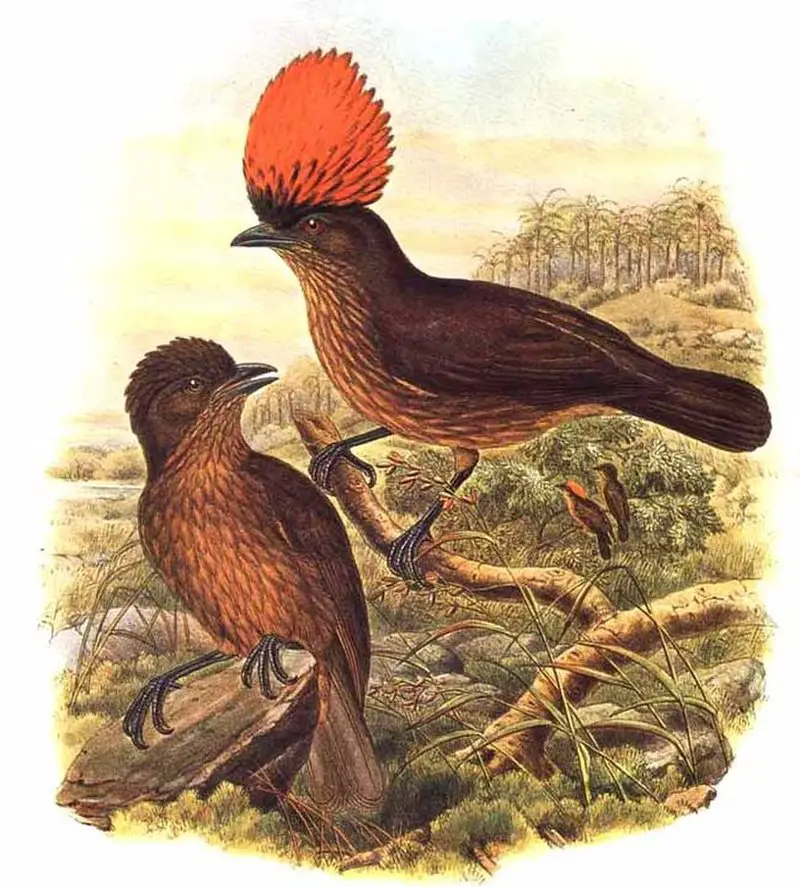
The Streaked Bowerbird is a fascinating species native to the Bird’s Tail Peninsula of southeastern New Guinea. It stands about 22 cm in length and has an olive-brown colouring with a short orange crest only visible when displayed.
Males are polygamous, building nests out of sticks that feature a characteristic hut shape.
The male builds several huts around its territory to attract potential mates by displaying objects such as stones or shells inside them during courtship rituals, while also singing songs and performing dances nearby.
Female bowerbirds select their mate primarily based on the quality of his nest and display items he presents her with.
Scientific classification:
| Kingdom | Animalia |
| Phylum | Chordata |
| Class | Aves |
| Order | Passeriformes |
| Family | Ptilonorhynchidae |
| Genus | Amblyornis |
| Species | A. subalaris |
34. Australian Magpie
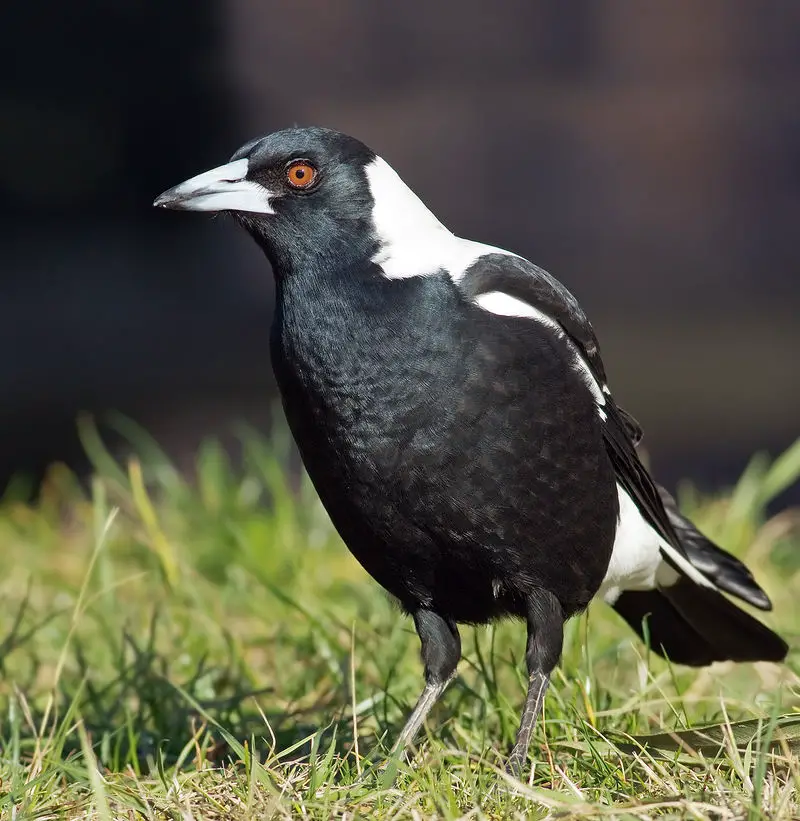
The Australian magpie is a beautiful passerine bird native to Australia and southern New Guinea.
It has distinctive black and white plumage, with males having more brightly coloured feathers than females.
The species is part of the Artamidae family, so it’s closely related to the Black Butcherbird (Melloria quoyi). Nine different subspecies have been recognised which vary slightly in size and colouring.
Magpies are omnivorous birds meaning they eat both plants and animals; their diet consists mainly of insects, small reptiles and amphibians as well as some grains such as wheat or oats.
They also enjoy drinking from pools of water on hot days. In general these birds display high intelligence when compared to other avian species – able to mimic human speech patterns quite accurately even in captivity.
Overall this majestic creature deserves our appreciation for its beauty, loyalty and fascinating behaviour.
Scientific classification:
| Kingdom | Animalia |
| Phylum | Chordata |
| Class | Aves |
| Order | Passeriformes |
| Family | Artamidae |
| Genus | Gymnorhina Gray, GR, 1840 |
| Species | G. tibicen |
35. Orange-Footed Scrubfowl
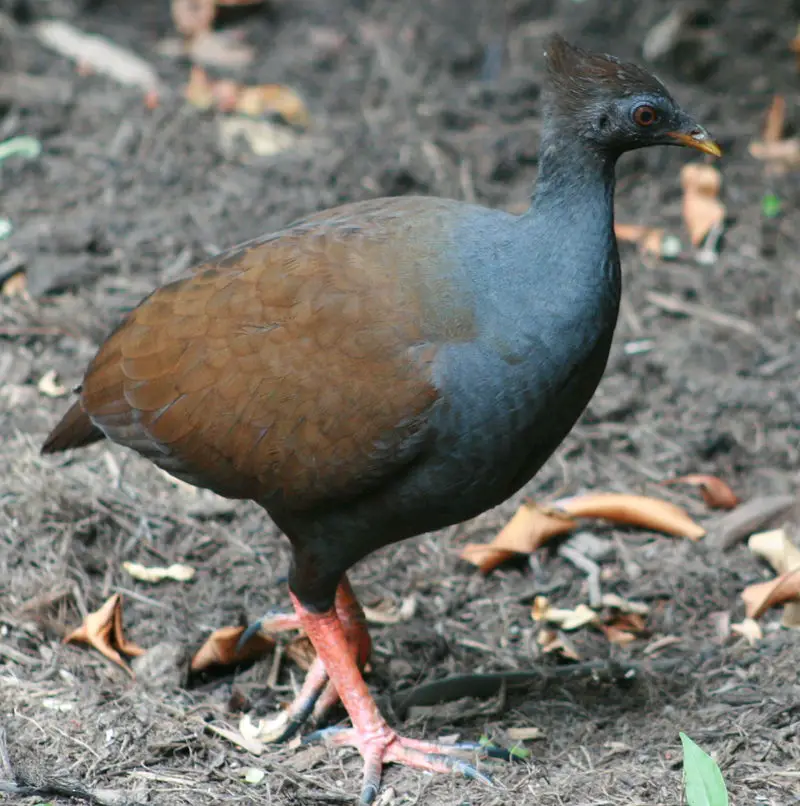
The Orange-footed Scrubfowl is a small Megapode of the family Megapodiidae found in several islands from Lesser Sunda Islands to southern New Guinea and northern Australia.
It has a dark brown coloration with bright orange legs and feet that stand out against its body, making it quite an eye-catching species.
The bird’s size is roughly equal to that of a domestic chicken.
This species feeds mainly on insects, fruits, seeds and roots but will also scavenge for carrion or feed on worms when available.
They are typically solitary birds except during breeding season when they tend to form colonies near their nesting sites usually along beaches or sand dunes where they can use the heat generated by the sun reflecting off the sand in order to incubate their eggs without having build nests themselves.
Overall this unique bird stands apart from other members of its family due to its striking plumage as well as being one of few ground dwelling megapodes instead of tree dwellers like most others within this group which makes them relatively easy to spot among greenery if you know what you’re looking for.
Scientific classification:
| Kingdom | Animalia |
| Phylum | Chordata |
| Class | Aves |
| Order | Galliformes |
| Family | Megapodiidae |
| Genus | Megapodius |
| Species | M. reinwardt |
36. Varied Triller
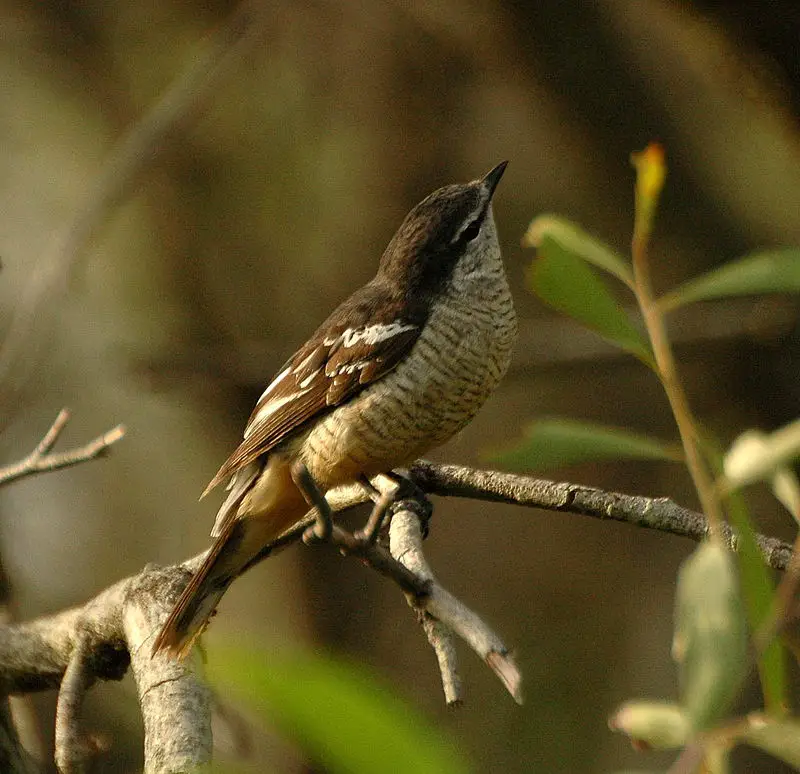
The varied triller is a small, colorful bird belonging to the cuckoo-shrike family. Native to New Guinea and the Bismarck Archipelago as well as parts of eastern Australia, this species prefers warm, fairly moist climates.
It has an unmistakable plumage that includes white wings with black barring and bright yellow underparts.
The head is grayish-brown while its tail feathers are largely brown but tipped in white.
Its call consists of a series of short whistles which it uses both for communication among flock members and territorial defense against other birds or predators in the area.
Although not widely known compared to some other avian species, these delightful birds can be seen flitting about their natural habitats if one knows where to look.
Scientific classification:
| Kingdom | Animalia |
| Phylum | Chordata |
| Class | Aves |
| Order | Passeriformes |
| Family | Campephagidae |
| Genus | Lalage |
| Species | L. leucomela |
Also Featured In: Birds that Live in Sunshine Coast, Common Townsville Birds
37. Yellow-Billed Kingfisher
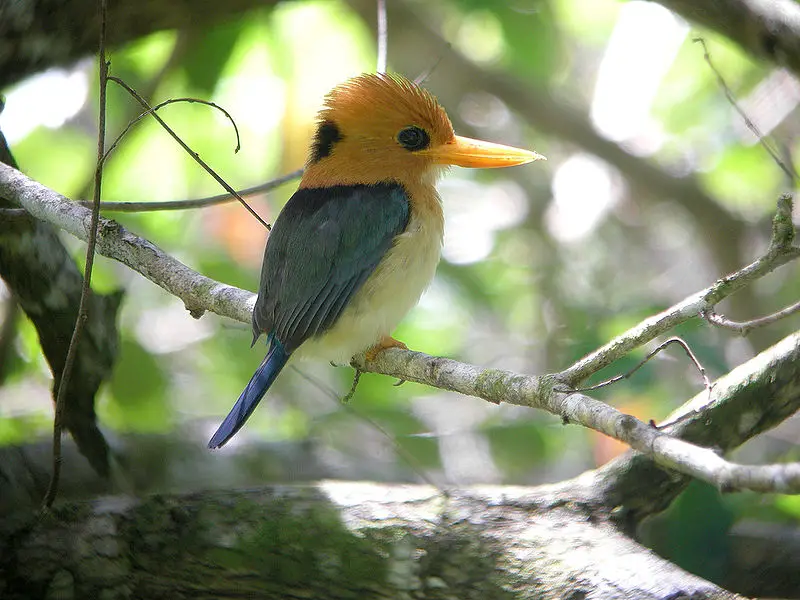
The Yellow-billed Kingfisher is an impressive bird that stands out for its distinctive yellow bill and orange head. It has a black nape patch and white throat, with adult females also having a brownish wash on their back, wings and tail feathers.
This medium-sized tree kingfisher grows to be around 20 cm long and can have up to 29 cm in wingspan; weighing between 30 – 50 gms.
There are three recognised subspecies of the Yellow-billed Kingfisher which differ mainly in size but all share the same striking colouring.
They usually live near rivers or other bodies of water where they hunt fish, amphibians or insects using their sharp bills as weapons against prey before consuming them whole.
Scientific classification:
| Kingdom | Animalia |
| Phylum | Chordata |
| Class | Aves |
| Order | Coraciiformes |
| Family | Alcedinidae |
| Subfamily | Halcyoninae |
| Genus | Syma |
| Species | S. torotoro |
38. Silver-Eared Honeyeater
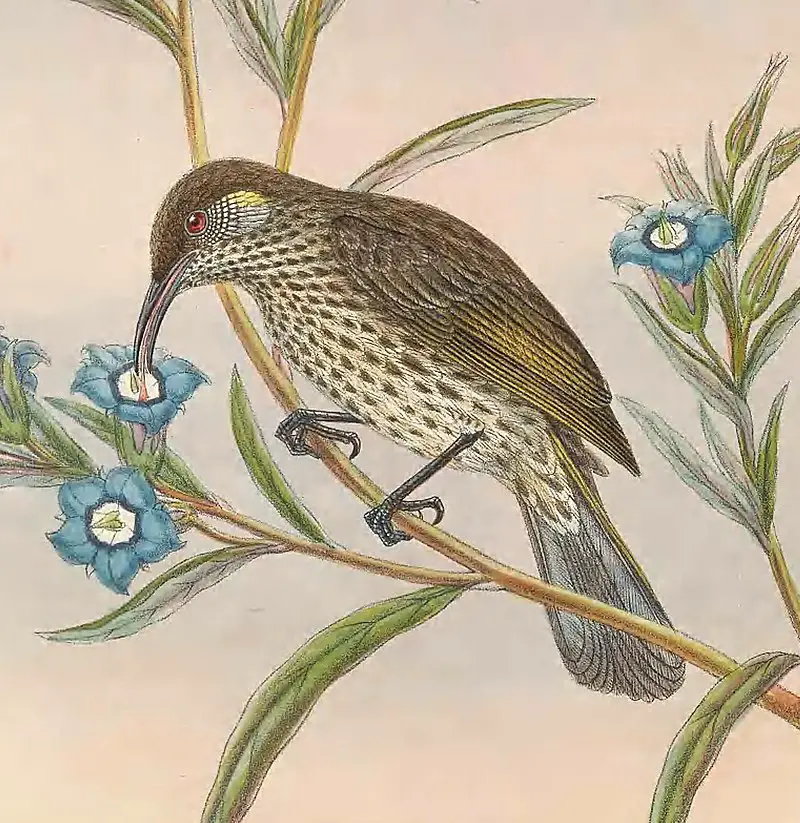
The Silver-eared honeyeater is a small bird native to New Guinea. It has distinctive white ear marks and mottled brown upperparts, as well as pale underparts with dark breast markings.
Its downcurved bill helps it feed on nectar from flowers or catch insects in the air.
This species makes its home in subtropical or tropical mangrove forests where it forages for food among tree branches and shrubs.
The Silver-eared honeyeater can be identified by its call which sounds like a series of musical notes that increase rapidly before ending abruptly.
As an important pollinator of forest plants, these birds are vital to their ecosystems’ health and vitality.
Scientific classification:
| Kingdom | Animalia |
| Phylum | Chordata |
| Class | Aves |
| Order | Passeriformes |
| Family | Meliphagidae |
| Genus | Lichmera |
| Species | L. alboauricularis |
Also Featured In: Silver Birds You Should Know,
39. Noisy Friarbird
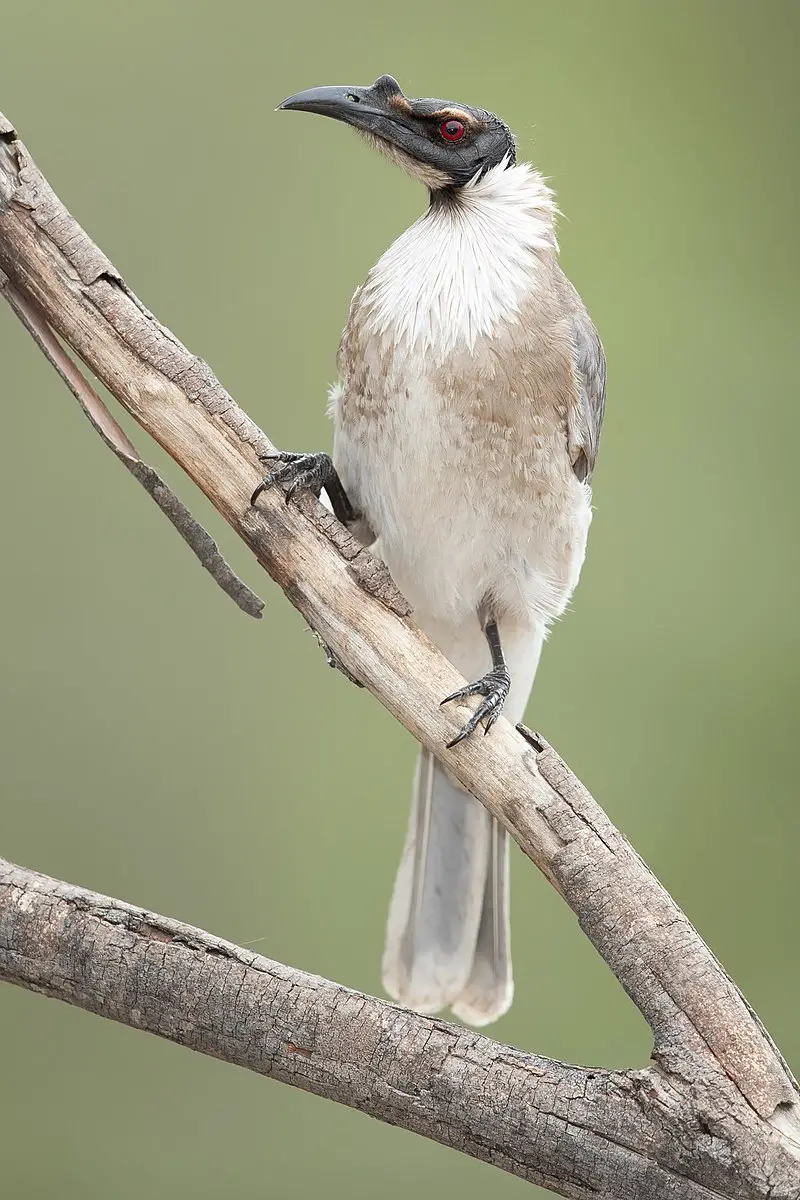
The Noisy Friarbird is a native of Southern New Guinea and Eastern Australia. It’s easily recognisable due to its brown-grey colouration, as well as the prominent knob on its head which is bare black skinned.
This bird belongs to the honeyeater family Meliphagidae, making it one of several species referred to as friarbirds with their featherless heads.
The diet for this particular species consists mainly of insects such as bees and ants, but also nectar from flowers when in season.
First described by ornithologist John Latham in 1802, they are commonly found near woodlands close to water sources like rivers or streams where there is plenty of food available during breeding season which usually occurs between August and December each year.
Scientific classification:
| Kingdom | Animalia |
| Phylum | Chordata |
| Class | Aves |
| Order | Passeriformes |
| Family | Meliphagidae |
| Genus | Philemon |
| Species | P. corniculatus |
Also Featured In: Birds that Live around Brisbane, New South Wales Birds You Need to See
40. Brown Sicklebill
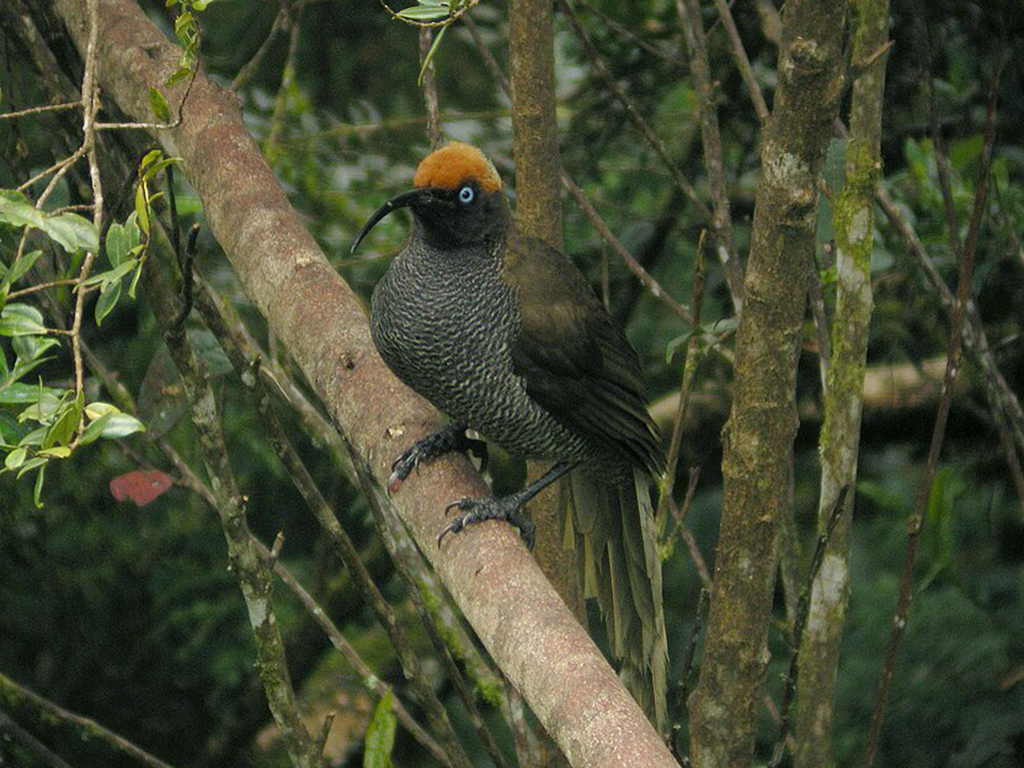
The Brown Sicklebill is a species of bird-of-paradise found in the mountain forests of New Guinea. It resembles its larger relative, the Black Sicklebill, and has replaced it in higher altitudes where they coexist.
Its diet consists mainly of fruits, arthropods and small animals. The male’s plumage features an overall brown colouration with lighter patches on its wings and tail feathers; this makes it easy to distinguish from other birds in the area.
During courtship displays, males will raise their crowns into a crest while spreading out their tails like fans as they perform aerial acrobatics for potential mates.
These behaviours are all part of showing off their impressive physical traits – namely, bright red eyes surrounded by golden yellow tufts that extend towards his beak which appears curved at one end resembling a sickle blade.
Scientific classification:
| Kingdom | Animalia |
| Phylum | Chordata |
| Class | Aves |
| Order | Passeriformes |
| Family | Paradisaeidae |
| Genus | Epimachus |
| Species | E. meyeri |
41. Belford’s Melidectes
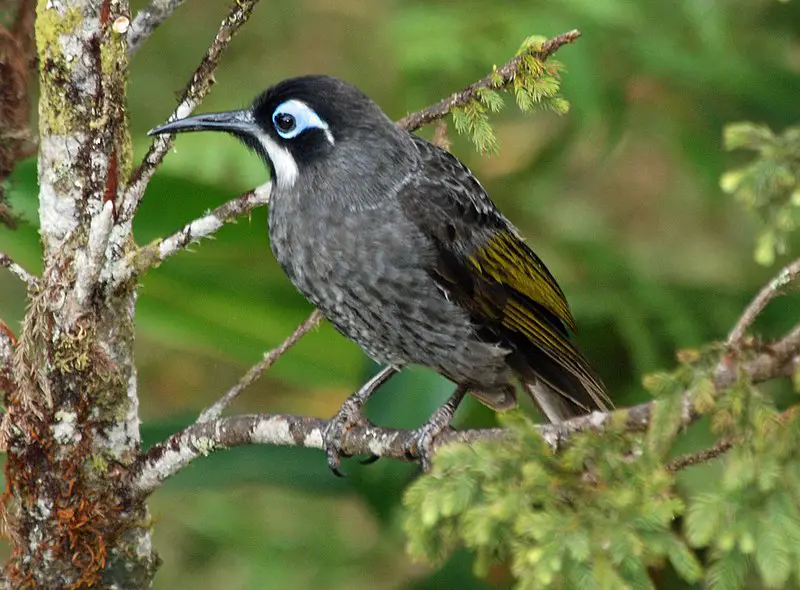
Belford’s melidectes is a species of bird found in New Guinea. It belongs to the family Meliphagidae and lives in subtropical or tropical moist montane forest.
These birds are named after George Belford, son of a Samoan chief who collected natural history specimens for Sir William McGregor, Lieutenant Governor of Fiji.
The plumage on its upperparts is olive green while their underparts have yellowish gray coloration with some brown streaks near the chest area.
They also possess long curved beaks which they use to feed upon small fruits and insects from trees as well as shrubs located within forests areas where these birds live.
In addition, they are capable of producing loud calls which can travel distances through dense rainforest vegetation making them quite easily recognisable when heard among other birdsong emanating from such habitats.
Scientific classification:
| Kingdom | Animalia |
| Phylum | Chordata |
| Class | Aves |
| Order | Passeriformes |
| Family | Meliphagidae |
| Genus | Melidectes |
| Species | M. belfordi |
42. Scheepmaker’s Crowned Pigeon
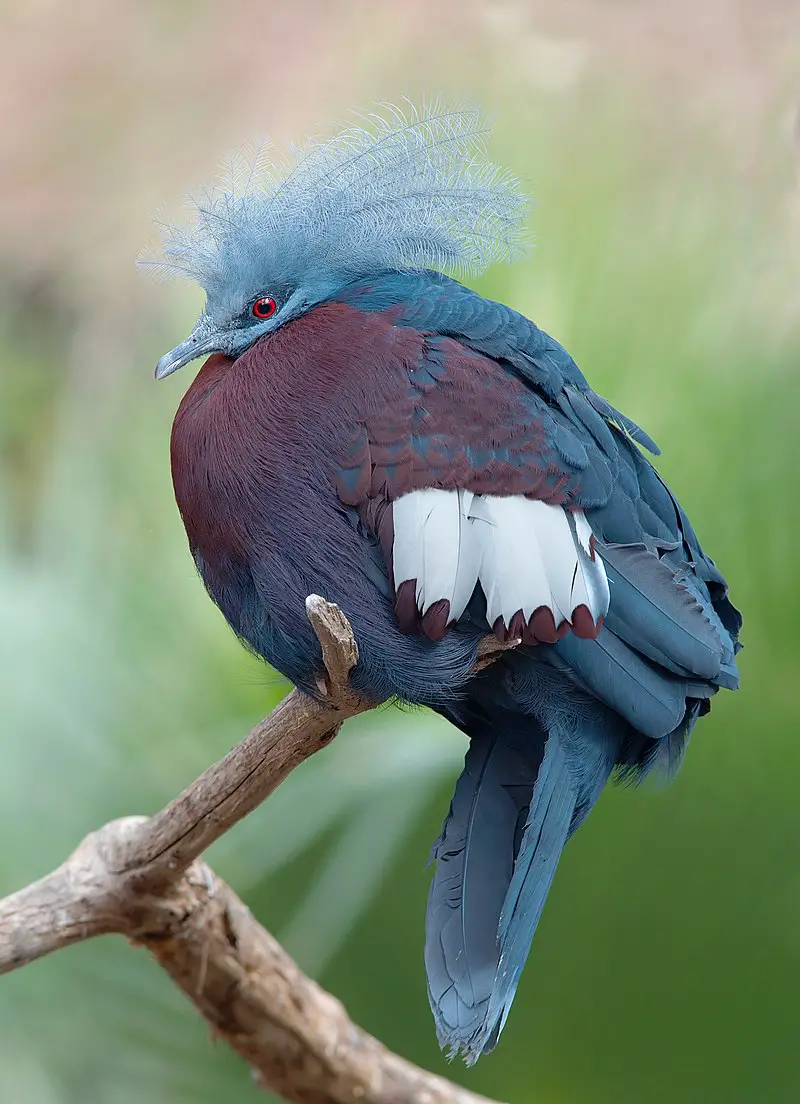
Scheepmaker’s crowned pigeon is a large and truly majestic bird found only in the lowland forests of south eastern New Guinea.
It has an impressive plumage that consists of bluish-grey feathers with elaborate blue lacy crests, red iris, and maroon breast.
Both sexes share similar physical features such as its size—averaging 70 cm (28 in) long and 2,250 grams (5 pounds)—making this species one of the largest living pigeons.
Its grandeur appearance makes it one of nature’s most incredible animals to observe in their natural habitat.
Scientific classification:
| Kingdom | Animalia |
| Phylum | Chordata |
| Class | Aves |
| Order | Columbiformes |
| Family | Columbidae |
| Genus | Goura |
| Species | G. scheepmakeri |
43. Yellow-Browed Melidectes
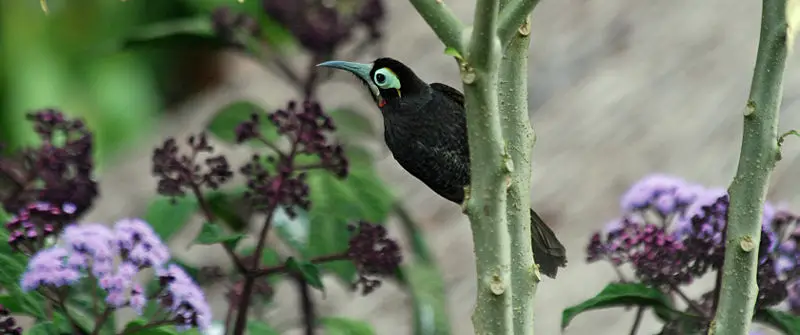
The Yellow-browed Melidectes is a species of bird that belongs to the family of Meliphagidae. It can be found mainly in Papua New Guinea and its natural habitat consists of subtropical or tropical moist montane forests.
This small sized honeyeater has an olive green upper body with yellow streaks on their brow, white underparts, black wings and tail feathers tipped whitish grey color.
They mostly feed on insects but also enjoy fruits as well.
The melidectes tend to live in pairs or small groups while they are foraging during the day time only within their territory which makes them quite territorial birds when it comes to defending this area from intruders like other birds etc.,
Furthermore these little guys have been known to use tools such as twigs and leaves while searching for food underneath bark.
Scientific classification:
| Kingdom | Animalia |
| Phylum | Chordata |
| Class | Aves |
| Order | Passeriformes |
| Family | Meliphagidae |
| Genus | Melidectes |
| Species | M. rufocrissalis |
44. Red-Breasted Pygmy Parrot
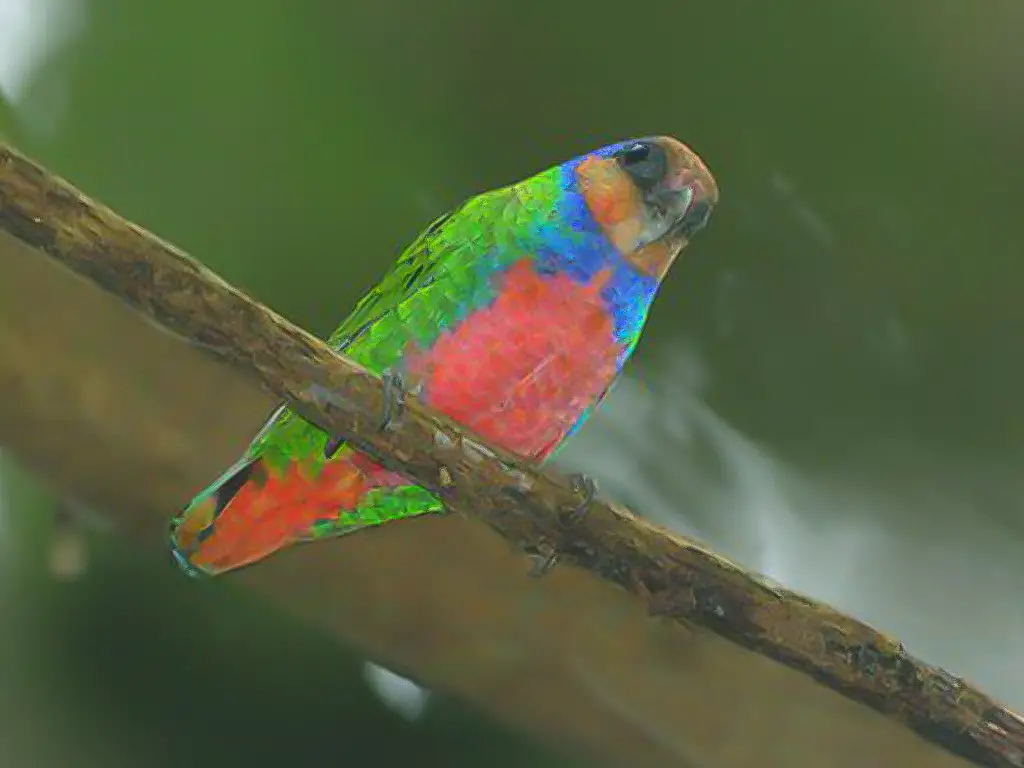
The Red-breasted Pygmy Parrot is a small species of parrot found in the Maluku Islands and Melanesia. They are known as the smallest genus of all parrots, measuring only up to 10 cm long.
These brightly coloured birds have striking crimson red breast feathers that contrast against their mostly green body plumage. They usually live in boreal forests, subtropical or tropical dry forests and lowland moist forest areas.
The diet consists mainly of fruits such as figs, nuts and flowers with some insects too.
In terms of breeding behaviour they nest inside tree cavities high above ground level; typically there will be two white eggs laid at once which take around three weeks to hatch into chicks ready for fledging after six weeks.
This species has been listed on IUCN’s Red List since 2004 due to habitat destruction leading to population decline – it’s therefore important we protect these delicate creatures for future generations.
Scientific classification:
| Kingdom | Animalia |
| Phylum | Chordata |
| Class | Aves |
| Order | Psittaciformes |
| Family | Psittaculidae |
| Genus | Micropsitta |
| Species | M. bruijnii |
45. Stephan’s Emerald Dove
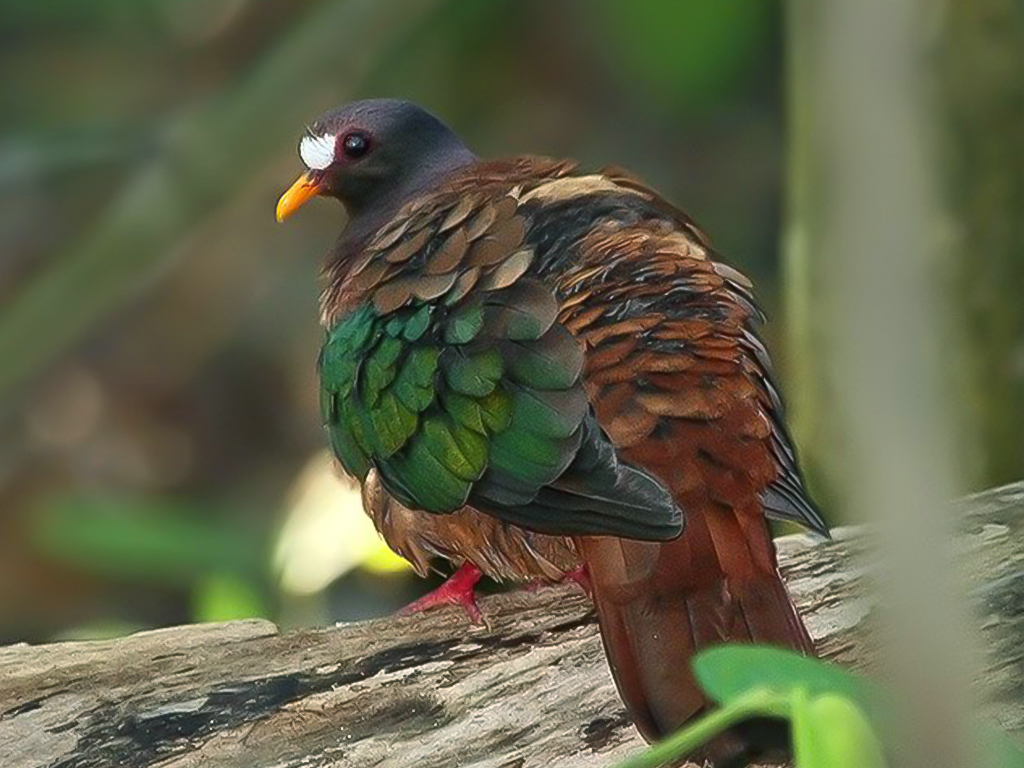
Stephan’s emerald dove is a stunning species of bird that belongs to the Columbidae family. It can be found in Sulawesi, New Guinea and Solomon Islands.
With its deep green body plumage combined with bright yellow underparts and dark wings, this small yet beautiful creature makes for an impressive sight.
Its tail feathers are tipped with red giving it a truly eye-catching look which adds to its overall beauty even more so when seen up close.
The Stephan’s Emerald Dove also has two black stripes above both eyes as well as white spots on either side of their neck making them easy to spot out in nature among other birds within their range.
Scientific classification:
| Kingdom | Animalia |
| Phylum | Chordata |
| Class | Aves |
| Order | Columbiformes |
| Family | Columbidae |
| Genus | Chalcophaps |
| Species | C. stephani |
46. Black-Backed Butcherbird
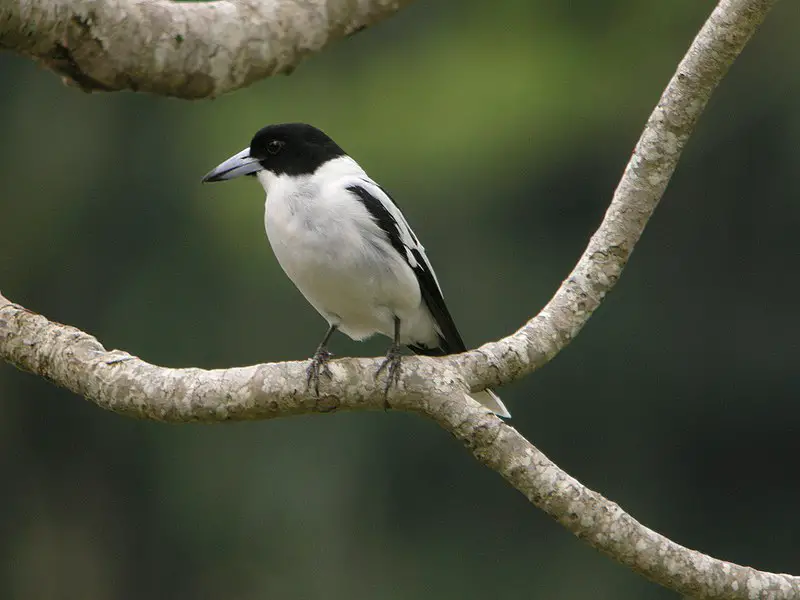
The Black-backed butcherbird is a species of bird in the Artamidae family, native to southern New Guinea and Cape York Peninsula. It was first described by Italian explorers Tommaso Salvadori and Luigi D’Albertis in 1876.
The scientific name mentalis translates as “mental noisy bird”, however this actually refers to its chattering call rather than any special intelligence.
This medium sized passerine has black feathers on its back with white spots, plus grey wings and tail.
Its beak is dark brown or black with yellow near the base. These birds mainly feed on small insects such as grasshoppers, caterpillars, beetles and cicadas found among foliage but they will also take fruit when available.
During breeding season they build their nests high up in trees which have an entrance at one side like a door way – hence why it’s sometimes known as ‘doorkeeper’.
Scientific classification:
| Kingdom | Animalia |
| Phylum | Chordata |
| Class | Aves |
| Order | Passeriformes |
| Family | Artamidae |
| Genus | Cracticus |
| Species | C. mentalis |
47. Pied Heron
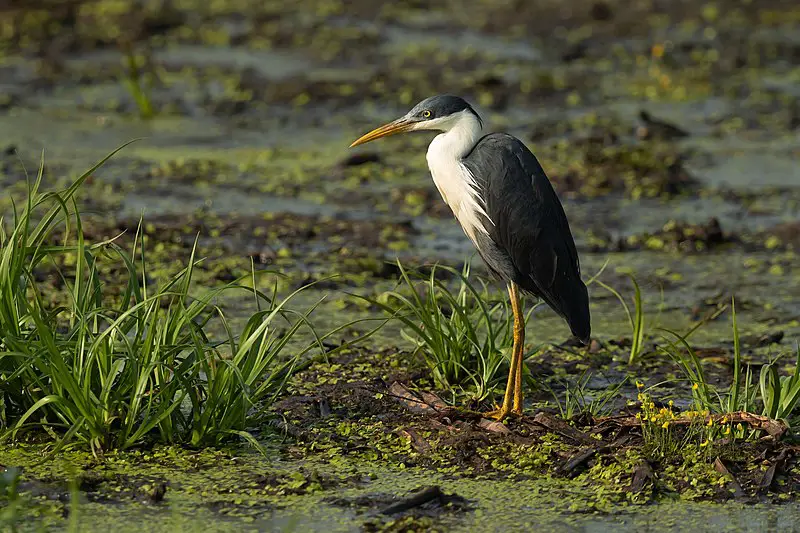
The Pied Heron is a small bird found in coastal and subcoastal areas of northern Australia, Wallacea, and New Guinea. It has no recognised subspecies and was first described by John Gould in 1845.
The average length of the adult heron can range from 43-55 cm long with a wingspan between 68-93cm wide.
Its distinctive appearance comes from its white chestnut body plumage as well as its gray crown feathers that are tipped black making it easily recognisable amongst other birds.
This species feeds on fish, amphibians, rodents and invertebrates which they hunt both during the day or at night depending on their location and preference for hunting times.
Scientific classification:
| Kingdom | Animalia |
| Phylum | Chordata |
| Class | Aves |
| Order | Pelecaniformes |
| Family | Ardeidae |
| Genus | Egretta |
| Species | E. picata |
48. Wattled Brushturkey
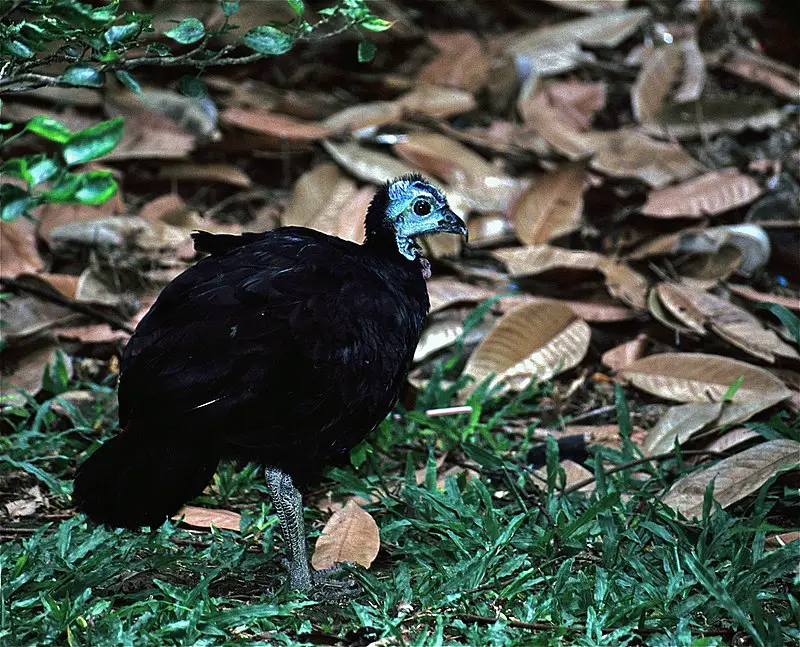
The wattled brushturkey is a species of bird that resides in New Guinea. It typically inhabits moist, lowland or montane forests across the tropical regions and primarily feeds on fruits, seeds and invertebrates.
This ground-dwelling bird has distinctive greyish-brown plumage with yellow wattle near its head region. Wattled Brushturkeys also have strong legs for running fast over rough terrain during times of danger.
They are usually found in small flocks but can be quite aggressive when defending their territories against intruders by displaying their wings and calling out loudly to scare them away.
Although they don’t migrate, they do tend to move around according to food availability throughout different seasons within an area.
Scientific classification:
| Kingdom | Animalia |
| Phylum | Chordata |
| Class | Aves |
| Order | Galliformes |
| Family | Megapodiidae |
| Genus | Aepypodius |
| Species | A. arfakianus |
49. Black-Billed Brushturkey
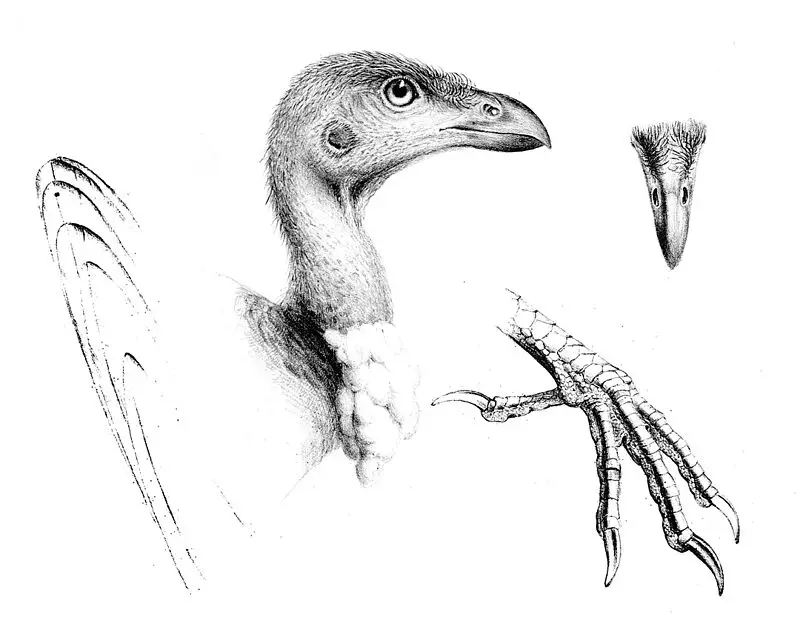
The Black-billed brushturkey is a species of bird found in the Aru Islands and New Guinea. It has brown feathers with black bills, yellow legs, and red wattles on its neck.
The natural habitat of these birds are subtropical or tropical moist lowland forests where they can find food as well as shelter from predators.
This species feeds mostly on fruits and insects but will also eat small invertebrates such as worms, snails, spiders etc.
During breeding season it constructs large mound nests made out of twigs and leaves which serves to incubate the eggs until hatching occurs.
These remarkable birds have been known to travel long distances for nesting sites making them an important part of their environment’s biodiversity ensuring that future generations continue to thrive within its ecosystem.
Scientific classification:
| Kingdom | Animalia |
| Phylum | Chordata |
| Class | Aves |
| Order | Galliformes |
| Family | Megapodiidae |
| Genus | Talegalla |
| Species | T. fuscirostris |
50. Collared Brushturkey
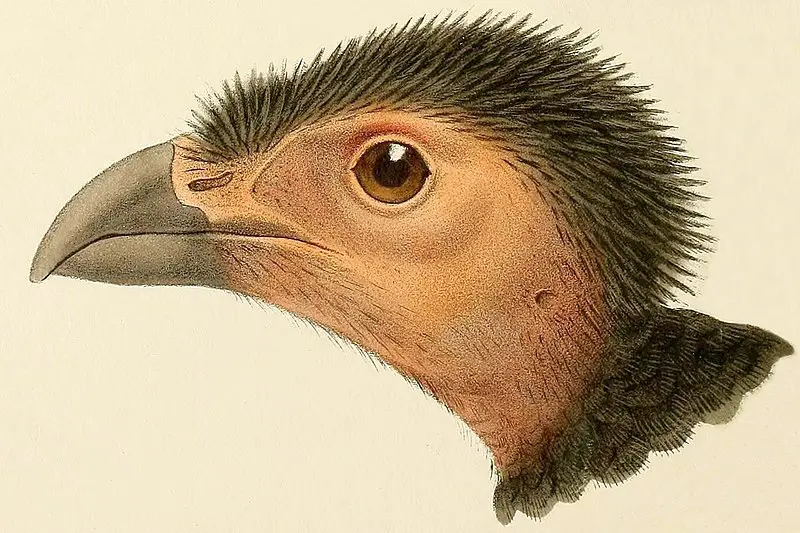
The collared brushturkey, also known as brown-collared or red-legged brushturkey, is a species of bird belonging to the family Megapodiidae. They are usually seen in subtropical and tropical moist forests of New Guinea’s northern region.
These birds have dark feathers on their backs while their chest and neck area has light yellowish coloration with prominent reddish legs.
They build large mounds out of leaves which they use for nesting purposes; these nests can measure up to three meters wide and one meter tall.
Moreover, this species feeds mainly on fruits, nuts, insects and other small invertebrates found in its habitat.
Collared Brushturkeys play an important role in maintaining healthy forest ecosystems by dispersing seeds from the food sources it consumes throughout its range.
Scientific classification:
| Kingdom | Animalia |
| Phylum | Chordata |
| Class | Aves |
| Order | Galliformes |
| Family | Megapodiidae |
| Genus | Talegalla |
| Species | T. jobiensis |
51. Zoe’s Imperial Pigeon
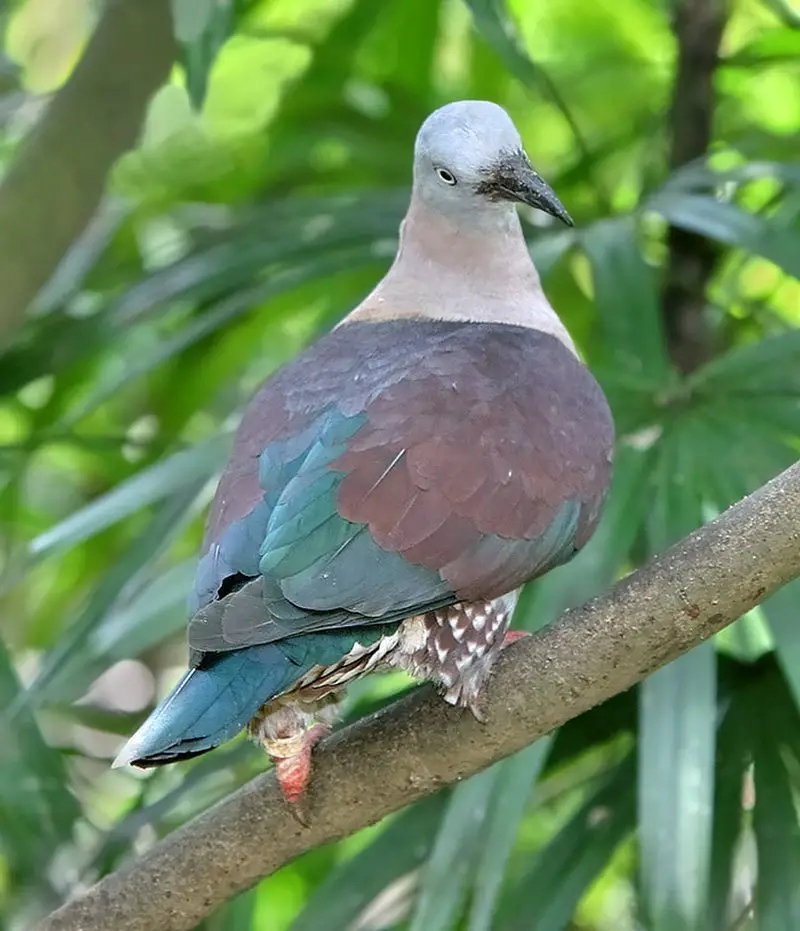
Zoe’s imperial pigeon is a species of bird found in the family Columbidae, native to New Guinea. It has adapted well to its natural habitats such as subtropical or tropical moist lowland forests, mangrove forests and montane forests.
Named after Zoë Lesson (fl. 1810), wife of French ornithologist René-Prim, it is a medium sized bird with an overall brownish colouration on its plumage while having black bands on its wings.
Its diet consists mainly of fruits which are supplemented by seeds and insects making it both frugivorous and omnivorous in nature.
As they often form flocks when searching for food these birds can be seen congregating around fruiting trees where their loud calls help alert other members about potential sources of food nearby allowing them easier access to resources within their environment .
Scientific classification:
| Kingdom | Animalia |
| Phylum | Chordata |
| Class | Aves |
| Order | Columbiformes |
| Family | Columbidae |
| Genus | Ducula |
| Species | D. zoeae |